Juha I. Uitto's Blog, page 13
June 20, 2011
Music for Lights @ Baruch Performing Arts Center, June 12, 2011
It is now three months since the unprecedented earthquake and tsunami ravaged northeastern Japan and, although much of Japan has returned to normal, recovery in the regions directly hit is still far away. Still now more than 90,000 people stay in temporary shelters. Then there is the whole nuclear hazard caused by the meltdown of three reactors in the Fukushima nuclear power plant. The Japanese authorities have clearly been complicit with TEPCO, the company that runs the plant, in playing down the extent of the disaster and it has come to light that the radiation escaped in the accident has been twice the level that was officially reported. All of this has implications to how soon—if ever—the inhabitants from around Fukushima can return home to restart their lives.
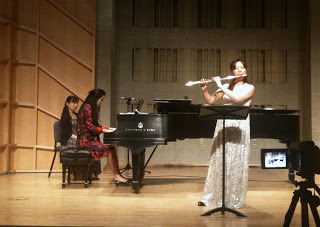
Music for Lights was a benefit concert for Japan relief efforts organized by two young Japanese women, Jun Kubo and Hiromi Abe, based in New York. Both are versatile musicians comfortable in a variety of idioms ranging from Western classical to jazz. The concert was held in the beautiful Engelman Recital Hall of the Baruch Performing Arts Center in New York City's Gramercy Park neighborhood.
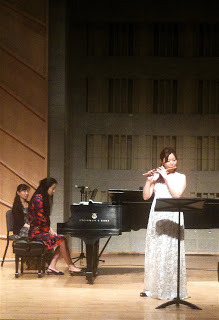
The two women started the concert with three duets for flute and piano. The first, Sonatine pour Flûte et Piano by Pierre Sancan (1916-2008), was a new acquaintance for me and I was taken by the beauty of the music. Jun Kubo's golden flute sounded lovely in the modern piece. Her tone is very smooth, especially in the lower register. I have earlier heard her in Meg Ogura's Pan Asian Jazz Orchestra and I have to say that her clean flute sounds more convincing in this classical context, rather than the contemporary band. Next Jun Kubo played Kojo no Tsuki, an old Japanese song which belongs to the shakuhachi repertoire. Kubo started the song with another type of bamboo flute, the transverse shinobue, before switching back to the Western flute. The arrangement was impressionistic and the overall performance quite low key. Hiromi Abe stumbled barely noticeably in some of the piano interludes. The ladies' performance ended with Sicilienne et Burlesque by Alfredo Casella (1883-1947), a rather playful piece in three parts, which suited the temperament of the two musicians well.
In between the pieces, Jun Kubo, who left Japan at 10 but keeps close contact there and even speaks the language fluently, told the audience how she had been in a meeting in Tokyo when the earthquake struck. By that time, she had already been five months pregnant. She had initially thought it was one of the "routine" Japanese earthquakes, but realized that this was something different when all the Japanese colleagues rushed screaming under their desks.
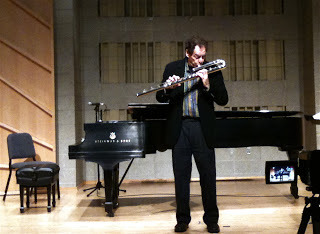
The star of the event was Jun Kubo's former teacher, Robert Dick. He has been called by some—and with some justification—the best flute player in the world. Dick is technically superior and enormously creative on flutes of various length. Like his young student, Dick is enormously versatile and at home in many kinds of music. Unlike her, though, he can be quite untamed when the music so requires. This was the third time I had the chance to witness his live performance and every time the setting has been entirely different. Again this evening the music presented a different side of the maestro. Dick briefed the rather conservative looking audience before starting his performance, saying that the best way to listen to his music was, well, just to listen to it: "Don't worry about the flute, that's my job."
Robert Dick began his segment of the concert with his own 1973 composition, Afterlight, an expressionistic exploration of the flute in which he blew two, three, even four tones at the same time, at times creating a rather eerie atmosphere. He then moved on to play the Sonata Appassionata composed by Sigfried Karg-Elert (1877-1933) in 1917, thus establishing his classical music bona fides before returning to his own compositions. What followed was Bells for Diz, a bass flute improvisation dedicated to Dizzy Gillespie who, as Robert Dick remarked, had two different stage personalities: one extremely focused when playing the trumpet and another, bubbling and lively when playing Afro-Caribbean percussion. Bells for Diz was an homage to the latter and the creative composer-performer used the big curved flute to generate an array of percussive sounds using the big keypads and blowing into the flute in various ways. The resulting music was inventive and joyful.
The final piece introduced a Dick invention, the glissando headjoint, which on the flute performs the same function as the whammy bar on an electric guitar. The inventor was initially inspired by Jimi Hendrix' guitar playing to explore how to create similar effects on the flute. He then worked over many years with instrument makers to realize his invention. The piece that concluded his part of the concert was a blues in which Robert Dick stretched the possibilities of the flute. The piece started and ended with slow slide guitar like licks. In between, he demonstrated a resourceful musicality and stunning technique moving from the blues to West African native flute tonalities and back via impressive runs.
Following Robert Dick in a concert is an unthankful position to be in. Therefore it was just as well that the next performer, singer Sahoko Sato, switched gears and genres entirely. The mezzo-soprano sang four songs accompanied by Rikako Asanuma (this young pianist is a native of Iwate, the prefecture in Japan closest to the epicenter of the March earthquake). These included Ave Maria by Pietro Mascagni (1963-1945); Kono Michi, composed by Kousaku Yamada (1886-1965) to a poem by Hakushu Kitahara (1885-1942); Chiisana Sora, an unusually conventional song by Toru Takemitsu (1930-1996), which he had written for a 1962 Japanese TV drama for children; and a Rogers & Hammerstein number, You'll Never Walk Alone.
The concert ended with a tune by one of the co-organizers, Hiromi Abe, who herself hails from Soma town in Fukushima prefecture. She told about the panicky times when it took her more than 24 hours after the earthquake to be able to get in touch with her parents who still live there (we had the same harrowing experience in trying to connect with my mother-in-law in Iwate). Abe's parents were safe but their town lost 500 people to the tsunami. Now Soma, just over 50 km from the Fukushima reactor, faces an uncertain future. Hiromi Abe ended the concert with her own song, To the People of Our Hometown Who Became the Light, with English lyrics translated by her friend Hitomi Demura-Devore. Sitting behind the grand piano, Abe accompanied herself as she sang, slightly tentatively, her mellow jazz-influenced ballad. It was clear to the audience that the words that she sang in a husky voice came straight from the heart.

Music for Lights was a benefit concert for Japan relief efforts organized by two young Japanese women, Jun Kubo and Hiromi Abe, based in New York. Both are versatile musicians comfortable in a variety of idioms ranging from Western classical to jazz. The concert was held in the beautiful Engelman Recital Hall of the Baruch Performing Arts Center in New York City's Gramercy Park neighborhood.

The two women started the concert with three duets for flute and piano. The first, Sonatine pour Flûte et Piano by Pierre Sancan (1916-2008), was a new acquaintance for me and I was taken by the beauty of the music. Jun Kubo's golden flute sounded lovely in the modern piece. Her tone is very smooth, especially in the lower register. I have earlier heard her in Meg Ogura's Pan Asian Jazz Orchestra and I have to say that her clean flute sounds more convincing in this classical context, rather than the contemporary band. Next Jun Kubo played Kojo no Tsuki, an old Japanese song which belongs to the shakuhachi repertoire. Kubo started the song with another type of bamboo flute, the transverse shinobue, before switching back to the Western flute. The arrangement was impressionistic and the overall performance quite low key. Hiromi Abe stumbled barely noticeably in some of the piano interludes. The ladies' performance ended with Sicilienne et Burlesque by Alfredo Casella (1883-1947), a rather playful piece in three parts, which suited the temperament of the two musicians well.
In between the pieces, Jun Kubo, who left Japan at 10 but keeps close contact there and even speaks the language fluently, told the audience how she had been in a meeting in Tokyo when the earthquake struck. By that time, she had already been five months pregnant. She had initially thought it was one of the "routine" Japanese earthquakes, but realized that this was something different when all the Japanese colleagues rushed screaming under their desks.

The star of the event was Jun Kubo's former teacher, Robert Dick. He has been called by some—and with some justification—the best flute player in the world. Dick is technically superior and enormously creative on flutes of various length. Like his young student, Dick is enormously versatile and at home in many kinds of music. Unlike her, though, he can be quite untamed when the music so requires. This was the third time I had the chance to witness his live performance and every time the setting has been entirely different. Again this evening the music presented a different side of the maestro. Dick briefed the rather conservative looking audience before starting his performance, saying that the best way to listen to his music was, well, just to listen to it: "Don't worry about the flute, that's my job."
Robert Dick began his segment of the concert with his own 1973 composition, Afterlight, an expressionistic exploration of the flute in which he blew two, three, even four tones at the same time, at times creating a rather eerie atmosphere. He then moved on to play the Sonata Appassionata composed by Sigfried Karg-Elert (1877-1933) in 1917, thus establishing his classical music bona fides before returning to his own compositions. What followed was Bells for Diz, a bass flute improvisation dedicated to Dizzy Gillespie who, as Robert Dick remarked, had two different stage personalities: one extremely focused when playing the trumpet and another, bubbling and lively when playing Afro-Caribbean percussion. Bells for Diz was an homage to the latter and the creative composer-performer used the big curved flute to generate an array of percussive sounds using the big keypads and blowing into the flute in various ways. The resulting music was inventive and joyful.
The final piece introduced a Dick invention, the glissando headjoint, which on the flute performs the same function as the whammy bar on an electric guitar. The inventor was initially inspired by Jimi Hendrix' guitar playing to explore how to create similar effects on the flute. He then worked over many years with instrument makers to realize his invention. The piece that concluded his part of the concert was a blues in which Robert Dick stretched the possibilities of the flute. The piece started and ended with slow slide guitar like licks. In between, he demonstrated a resourceful musicality and stunning technique moving from the blues to West African native flute tonalities and back via impressive runs.
Following Robert Dick in a concert is an unthankful position to be in. Therefore it was just as well that the next performer, singer Sahoko Sato, switched gears and genres entirely. The mezzo-soprano sang four songs accompanied by Rikako Asanuma (this young pianist is a native of Iwate, the prefecture in Japan closest to the epicenter of the March earthquake). These included Ave Maria by Pietro Mascagni (1963-1945); Kono Michi, composed by Kousaku Yamada (1886-1965) to a poem by Hakushu Kitahara (1885-1942); Chiisana Sora, an unusually conventional song by Toru Takemitsu (1930-1996), which he had written for a 1962 Japanese TV drama for children; and a Rogers & Hammerstein number, You'll Never Walk Alone.
The concert ended with a tune by one of the co-organizers, Hiromi Abe, who herself hails from Soma town in Fukushima prefecture. She told about the panicky times when it took her more than 24 hours after the earthquake to be able to get in touch with her parents who still live there (we had the same harrowing experience in trying to connect with my mother-in-law in Iwate). Abe's parents were safe but their town lost 500 people to the tsunami. Now Soma, just over 50 km from the Fukushima reactor, faces an uncertain future. Hiromi Abe ended the concert with her own song, To the People of Our Hometown Who Became the Light, with English lyrics translated by her friend Hitomi Demura-Devore. Sitting behind the grand piano, Abe accompanied herself as she sang, slightly tentatively, her mellow jazz-influenced ballad. It was clear to the audience that the words that she sang in a husky voice came straight from the heart.
Published on June 20, 2011 06:00
May 22, 2011
Oran Etkin @ Barbes, May 21, 2011
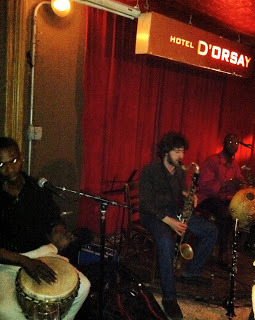
This Saturday night some forty people witnessed excellent intercultural musical cooperation in the shabby backroom of Barbès in Brooklyn where Israel-born Oran Etkin was joined by two Malian musicians, Makane Kouyate and Yacouba Sissoko. The combination of clarinet, kora and calabash is unusual enough, but the musical cross-fertilization and sheer talent of the trio made the event memorable. In the beginning, I thought the music lacked a bit in foundation, because there was no bass in the band. Both kora and clarinet play in treble pitches. However, this shortcoming—mostly in my own head and expectations—was soon overcome, largely because of Makane's amazing handling of the calabash. While playing complex rhythms and a remarkable range of tones by handling the single drum with his hands and fingers, he was also able to produce a steady bass beat with the base of his hand.
The music was basically based on West African rhythms and tones to which Oran brought his jazz and klezmer influenced clarinet. The concert started with a joyful tune, to be followed by a more melancholy love song, in which Oran switched to bass clarinet. The entire performance alternated between speedier jams and thoughtful and invariably very beautiful pieces mostly featuring the deep sounds of the larger curved clarinet.
Makane was the flashiest performer of the evening. In addition to his calabash, he sang the vocal numbers in an expressive lamenting voice. His percussion work was marvelous. Without warning, he would change the rhythm into double tempo and play flamboyant solos while the kora would keep the tune moving with a steady ostinato. All in all, there was a phenomenal cooperation between the musicians, with the clarinet and kora joining in unison as the drum would strike powerful thumps and bangs to signify a change in a segment or to end a song in a catchy phrase.
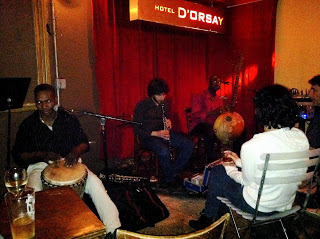
Barbès is a small bar and music space in Brooklyn's Park Slope. It is run by two Frenchmen who named it after the Paris neighborhood, which has a large North African immigrant population. The Brooklyn place has a distinctly Parisian underground feel and a clientele who perfectly fits into the scene. The age range is wide but a certain bohemian demeanor seems to unite the generations. The highly atmospheric music was further lubricated by freely flowing wine and cocktails, which the patrons imbibed in quantities. Although I was irrigating my own throat only with Diet Coke, I did not find any of my fellow audience to be the least annoying, not even those who were clearly quite well marinated.
Oran Etkin is a remarkably creative musician. A student of Yusef Lateef, he has taken after his legendary teacher in his open mind and broad musical vision that bridges a whole range of genres and cultural traditions in an eclectic manner. Lateef (born in 1920 and still going strong) has for decades been one of my greatest inspirations just for the reason of his limitless imagination and incorporation of African, Middle Eastern and Asian music into his own special style. In fact, one of the most intriguing numbers of the evening was a quirky slow blues-based tune that Oran said he had written for his mentor and played on a wailing clarinet. It also took the kora to directions and dimensions that are not normally heard on the stringed instrument. Yacouba Sissoko, however, is a master kora player who has the facility and musical sense to manage such challenges.
The concert was further spiced up by Oran's good-humored banter in between the tunes. He encouraged the audience to participate in an African style call and response chorus in one of the songs sung by Makane and he also gave people the license to dance, which they took up with delight. During the last number, Yekeke, I observed a middle-aged white couple who were totally absorbed in the moment. The woman shook in overtime as if possessed by a Mandingo spirit, while her partner wearing a pale blazer seemed to imitate former President George W. Bush when he joined in a tribal dance performance during one of his visits to Africa. But how could I blame them? Such was the intensity of the music and rhythm produced by this unorthodox acoustic trio.
Published on May 22, 2011 17:49
May 14, 2011
Delhi Heat
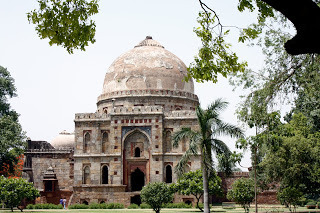
Delhi is hot. I mean not warm and sunny. I mean searing hot. The sun is shining from a cloudless sky and the temperature is around +40 degrees Celsius. As we walked the few hundred metres to have lunch at the India International Centre, Jayati with whom I am working here remarked: "You're lucky you weren't here last week; now it's a bit cooler." But according to the forecast would soon again get warmer—and indeed, on May 12th the year's record was broken with an official high of +43.1 degrees Celsius. Khushwant Singh, the famous Indian writer, sums it up in his latest, The Sunset Club: "It is said hell is a very hot place. If you want a foretaste of what may be your fate, you should spend the month of June in Delhi." It is now May, and maybe this is only a foretaste of what comes after.
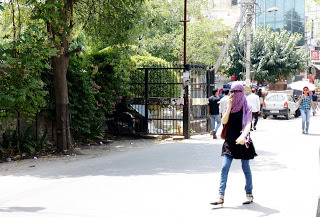
Last time I was here, in January, just four months ago, it was freezing. The cold and damp fog of winter enveloped the city for weeks. A dozen or more people died as the frigid winds blew down to the northern plains from the Himalayas. Now they die of the heat. People with no shelter, exposed to the vagaries of climate. It is the rag pickers and the poor elderly who perish when the weather gets too cold or too hot. Or when it floods. Delhi is renowned for its floods when the monsoon rains come later in the year. The river Yamuna, which crosses the vast conglomeration, rises above its banks. The slums are soaked and again poor people are washed away with the waters. Which kills more people, I ask myself. So far, it is not the cold of the winter, although the seasons are getting quite extreme lately. Which way would I prefer myself, if I had the unenviable choice? They say one feels numb and warm before one passes away from freezing. Drowning is supposed to bring along a calm, with a light that shines presumably from somewhere above. But how do they know? As far as I can see, nobody has really died and come back to tell. I think that, considering the options, I'd prefer succumbing to the heat. Maybe my brain is already overheating, as I'm thinking this way.
In the evening the heat subsides with the sun and it is actually quite pleasant. Hot and dry, but not suffocating. A couple of nights ago, I headed out by myself, as my travelling companion had acquired an acute case of 'Delhi Belly.' No wonder, as in this heat all kinds of micro-organisms thrive. It was more of a wonder in January, when it was cold, that I acquired a bad case of the same ailment. I attribute it to complacency. Then I had thought it was safe enough to eat salads and other uncooked food. Obviously I was badly mistaken. After a couple of agonizing days when I finally was strong enough to get on my feet I headed to the Max Healthcare Super Speciality Hospital. I could see why today so many people, including Westerners, choose to have themselves treated in Indian hospitals if they get gravely ill. Of course, this option is only available to those who can afford it; which is to say, perhaps the top 10 percent of Indians plus the foreigners who see the value of being treated here. The Max was a sprawling complex in a park-like setting, spanking clean, friendly, efficient and cheap by Western standards. After just a quarter of an hour wait, I was examined by the highly professional Dr. Monica Mahajan who discharged me with a set of prescriptions that I was able to pick up from the ground floor dispensary on my way out. Give me this anytime over an overpriced and unfriendly American hospital where they ask for your religious affiliation and credit card before they even start treating you.
This recent night I was perfectly fine and jumped into the tiny white Tata taxi that I had hired on a weekly basis to take me around. I asked the dark skinned moustachioed driver, Shiva Dayal, to take me to Khan Market. I wanted to visit the two fabulous bookstores operating at the popular place. Just a few years ago, this was just a local market. Today it is one of the fanciest shopping areas in New Delhi with lots of boutiques frequented by fancy ladies sporting expensive jewellery and handbags. Khan Market was crowded, the lights of the shops beckoned browsers. I first went to Bahri Sons, but soon realized they were about to close for the night. The two young women tending the cashier were no longer interested in making a sell. Instead they were counting the stack of bills the shop had collected from customers during the day, joking and giggling with each other. I decided to head to Faqir-Chand & Sons, a small but magnificent book handler not far away in the same row of shops. They gave me more leeway time-wise, as well as service-wise, and I was able to browse through their amazing and amazingly disorganized collections. In a place where the newest books on politics and international affairs lie next to an assortment of other tomes with no apparent connection through their topics—Jack London's Call of the Wild adjacent to Mein Kampf; biographies of Che Guevara and the Beatles next to a photographic guide to sex positions from Kama Sutra—one can find true surprises that one just has to purchase. I picked up an inspiring anthology of Indian environmental writing, Voices in the Wilderness: Contemporary Wildlife Writings, edited by Prerna Singh Bindra.
Having picked my selection, I continued to an alley on the side of Khan Market where several small doors lead up to discreet little bars. Discreet only from the outside, however. I climbed the stairs to one called Route 04 and found a noisy room crowded with mostly young people, all Indian, consuming quantities of beer and cocktails. I could see plates of nachos carried to the tables to be consumed by the lively customers. Many of the women were breathtakingly beautiful, as many Indians are, with their large dark eyes lined with kohl. It was still early on a Monday evening, but the DJ in a corner was playing Led Zeppelin at high volume. A group of fashionable kids were sharing an oversized hookah at a close-by table. As it was happy hour, I got a second bottle of Tuborg for the same price. IMFL, they call it: Indian made foreign liquor. I could have stayed for the rest of the evening, but I was getting hungry and the somewhat depressing looking pseudo-Mexican/New Yorker snacks did not appeal to me.
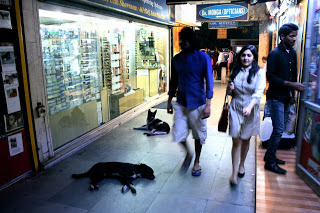
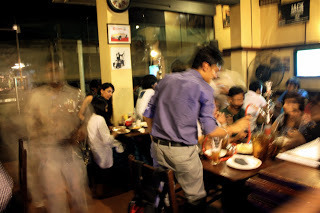
I asked Shiva to recommend a restaurant with good Indian food that also served beer. The latter was a condition I would not compromise upon tonight. He said he knew just the place for me and off we drove to a new shopping centre close to Lodhi Gardens not far from Khan Market. The restaurant was called Pindi and boasted a neon sign promising genuine Mughal and Chinese cuisine. It was brightly lit with tables lining the sides of two adjacent oblong rooms. I sat at one and started browsing the menu. Soon Shiva returned with the bad news: the place had no beer. A discussion ensued involving the portentous proprietor and a couple of waiters mixing Hindi and English in a way that left me completely confused. I was led to a less conspicuous corner table and told to sit down. The paunchy owner assured me that things would work out. I would just have to be discreet about my beer. He only had two left and he had already told a group of some half a dozen foreigners sitting in the next room that there was no beer. The manager did not want them to see that someone arriving after them was actually served the cold drink. I agreed to be prudent and a waiter brought me a can carefully wrapped in a paper towel, so that it would not be obvious to any observer that the tin contained the coveted brew. With this, the evening proceeded. In my euphoria I ordered far too much food: succulent Rada mutton, with large chunks of soft lamb attached to bone served in an onion sauce containing minced lamb; delicious Karani Paneer, cottage cheese stewed in wonderful gravy; white long-grained rice.
India's economy is growing rapidly and in the West this is often seen as a threat. People in the US complain about outsourcing of jobs, as well as about bright and hardworking Indian professionals taking jobs in America. Some of it may be true, but the thriving modern sector is still only a thin layer: icing on the boiling cake of India. Most of India is still very poor and this poverty has both a geographical dimension as well as many social aspects. Often these overlap. The UN ranks India 119th among 169 countries based on the Human Development Index. This ranking does not only include monetary income but takes into account aspects such as health and education. This puts India into the 'medium human development' category. The index, however, hides huge differences between people. These differences can be explained in numerous ways: historical and structural factors, the highly varying government policies between states, inefficiencies, corruption, the caste system, rural to urban migration, etc.
Some Indian states lie very far behind Delhi, Mumbai and other major cities in the level of human development. Within the big cities, too, the inequality between people is staggering. Huge slums sprout beside shiny new skyscrapers and fancy villas. Little children and severely handicapped people beg at each intersection in Delhi accosting cars as they have to stop at traffic lights. New Delhi is a gorgeously beautiful city with ample green parks lining the streets. Its majestic avenues linking parts of the spread-out city are good for cars but the distances are long for people without transportation. Old Delhi is different, picturesque for a casual visitor, but rough on those who must live there. Teeming with humanity, its narrow streets are cramped up and dirty, buildings crumbling. Violence flares up easily in poverty.
On 11 May 2011, in the middle of my stay here, the Planning Commission of the Government of India redrew the official national poverty line at Rp. 20, or less than US$0.50, per day. The motivation can only be to reduce the number of people living below the poverty line, so that India doesn't look so bad in international comparisons or so that the government doesn't have to extend social services to as many people. But poverty remains, wherever you draw the line.
On a recent night, my friend Nidhi took me to the Sikh temple, Gurudwara Bangla Sahib. The place was crowded and very welcoming to people of any creed or colour. We removed our shoes and were given saffron headscarves to cover our hair in respect to the Sikh faith and culture. The gorgeous white temple was alive with music as people gathered there for prayers. We walked slowly around the vast square pool reflecting the lights of the temple in the dark evening. The Sikhs are proud people, never to be found among the beggars. Instead they have formed a supportive social system whereby any person in need—and one does not have to be Sikh—can find food and shelter in the temple. A tall and thin pole with lights on top has been raised high to guide people to the temple from a long distance. Also now we observed a large crowd of men and women, young and old, who had gathered waiting on the porch of a big hall to be fed. As we passed by, the gates were opened and the people streamed in for their free meal.
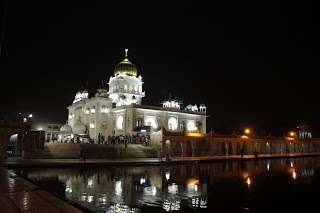
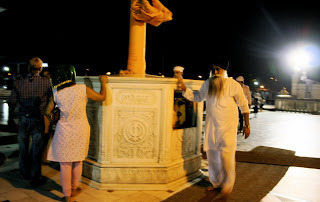
Our meal wasn't free at the Blues café and bar on Connaught Place at Delhi's commercial and business heart not too far from the temple. Sitting in the air-conditioned comfort listening to rather loud rock, we talked about the inequality and the persistence of abject poverty in India. Like Nidhi said, "Delhi is not a good place if you don't have money," The trouble is, there are so many who do not—and even the climate conspires against them.
Published on May 14, 2011 13:12
April 12, 2011
Musical Benefits for the Great Eastern Japan Earthquake Victims
On that fatal Friday, March 11, 2011, when the massive earthquake and tsunami struck Japan, the Tenri Gagaku orchestra was scheduled to play a concert at the Tenri Cultural Institute (TCI) near Union Square in Manhattan. Our phones were ringing as the TV poured live coverage of the wreckage in the distant island nation. My wife Yoko's home prefecture, Iwate, was at the heart of the disaster and she was not able to get in touch with family. She also plays ryuteki, a vertical bamboo flute in Tenri Gagaku. At last, it was decided that the concert would go on but that all proceeds from the ticket sales would be sent to Japan. Most certainly, this became the first in a long series of benefit concerts to aid the earthquake and tsunami victims. In the days and weeks to come when the extent of the disaster became clearer—and a nuclear hazard was added to the original woes—and that likely between 20,000 and 30,000 people had perished and many more left homeless and without livelihood, many musicians in New York, Japanese and foreign alike, joined forces to create some of the most innovative musical events to support the recovery in Japan. I had the honor of witnessing several of them and, thus in a small way, chipping in.
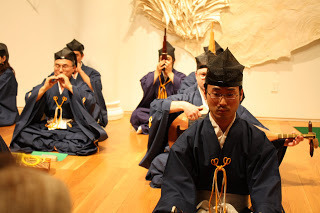
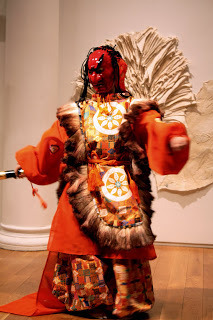
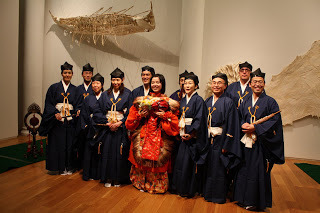
Tenri Gagaku @ Tenri Cultural Institute, 11 March 2011
Gagaku—literally translated as 'elegant music'—is the oldest form of orchestral music that has survived continuously in the world and Tenri Gagaku Music Society is arguably (but then again, I might be biased) the best gagaku group outside of Japan. The music has its roots in the Silk Road period during which gagaku-like music was widely played in various parts of Asia, ranging from China to Southeast Asia. From the Tang Dynasty (AD 618-907) court in China it traveled east and landed in the Japanese islands via the Korean peninsula. In its new home, Gagaku was refined over centuries and passed down through generations of court musicians who belonged to hereditary guilds. While Gagaku has disappeared from countries in continental Asia, in Japan it was played in the homes of the military aristocracy and later preserved as living tradition in the ceremonies of the Imperial family.
The instrumentation used in gagaku today consists of a number of wind, string and percussion instruments, such as the ryuteki, hichiriki (a kind of double-reed oboe with a nasal tone), sho (a mouth organ), the biwa lute, the koto zither, and various drums, the kakko (small drum), shoko (metallic percussion) and taiko (large drum). Gagaku has a quality to it that sounds odd to the unaccustomed ear, but it definitely grows on you when you listen to it more.
On this evening Tenri Gagaku played a set of slow court pieces, starting with 'Etenraku.' This is probably the most well-known piece in the gagaku repertoire. It has a simple but catchy melody played alternately by hichiriki and ryuteki. Gagaku as music is monophonic, meaning that the melodies are played in unison by all instruments. The only real harmonies are provided by the sho, which provides a kind of solid mat of sound to the music (think harmonium in Indian traditional music).
The last piece of the concert was a dance number, bugaku, performed by Tazuko Ikedo dressed in a heavy and colorfully decorated costume. This was Tazuko's last performance before returning to Japan after several years in New York, so it was not to be missed. Her slow and deliberate movements to the plodding music produced a somewhat hypnotic mood that definitely captivated the audience of some 100 people who had crowded into the TCI hall. Gagaku and bugaku are a total experience that provide a feast for both the visual and auditory senses.
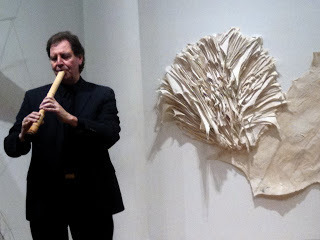
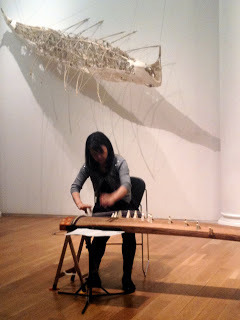
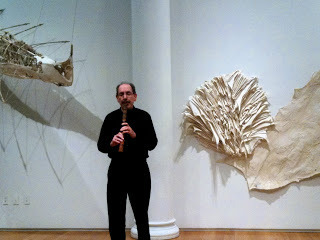
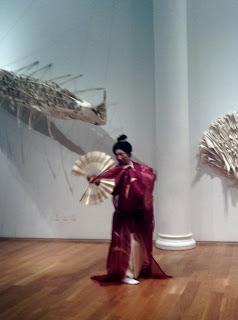
Concert for Japan @ Tenri Cultural Institute, 27 March 2011
Some two weeks later another Concert for Japan took place at TCI, this time featuring some of the foremost artists specializing in traditional Japanese music in New York. This concert was particularly precious for me, as it featured three shakuhachi masters: James Nyoraku Schlefer, Ronnie Nyogetsu Reishin Seldin and Ralph Samuelson. The concert started with 'Banshiki,' a tune belonging to the Meian Honkyoku tradition. The three masters were joined on stage with five shakuhachi students from the Tenri Cultural Institute. Clearly, 'Banshiki' was a tune that the students had to study and the group produced a decent version of the piece played on eight flutes that were only slightly out of tune. Some of the three men and two women were following closer in the footsteps of their teachers than others.
The concert also highlighted the versatility of the instrument to reflect the character of not only the music but equally the musicians. The temperaments of the three artists could not be more different and it was very interesting—and pleasurable—to observe how three players who are each trained in Japanese musical tradition and have reached the top levels in their chosen instrument could produce such differing artistic impressions. After the initial tune, the first concert performance was 'Haru no Umi' (or 'The Sea in Spring') featuring Nyoraku together with Masayo Ishigure, a masterful player of koto. 'Haru no Umi' is not a traditional Honkyaku piece, but rather a modern number composed by Michio Miyagi. It features lively dialogue between the two traditional instruments played in a not so traditional manner. The main theme of the composition is lovely and the variations indeed bring to mind the fickleness of the sea in springtime. It requires considerable skill from both instrumentalists and James played his part so smooth and clean that one could imagine listening to a Western flute instead of its bamboo ancestor.
'Jinbo Sanya' in the hands of Nyogetsu was an entirely different affair. The big man approaches shakuhachi from its original Buddhist perspective and had chosen this other Meian Honkyoku piece as his first solo number of the evening. The tune is haunting and Nyogetsu's interpretation used the full range of possibilities that the simple five-holed tube offers. The way he bent the tones using different techniques involving breathing, fingering, movement of lips, blowing angle and neck twists (known as kubi-furi, this is an essential, but hard to master technique for shakuhachi) produced remarkable sounds and effects that transported the listener to a medieval monastery in the misty mountains of Japan where the spirits of generations of Buddhist monks still linger.
Samuelson's first solo number was also a Honkyoku piece, but from a somewhat different tradition. The song entitled 'Choshi' was accompanied by the dancer Sachiyo Ito whose slow and sparse movements mirrored the music. Wearing a white kimono covered with a thin red coat, she moved deliberately with two fans in her hands to emphasize her choreography.
The first part of the concert ended with a koto solo by Masayo. It was 'Asa no Uta' or 'Morning Song' composed by her own teacher, Tadao Sawai. True to Sawai's style, this piece emphasized rapid movements and complex arpeggios. It was a koto player's delight, demonstrating virtuosity.
After the intermission, the three shakuhachi players returned each playing a solo piece. Nyoraku again started the set with a non-traditional tune, 'Ichijo' by Seiho Kinea. He explained to the audience in his jovial manner how the composer—a shamisen player who composed plenty of music for all Japanese instruments—had composed this tune in shock after a dear friend had "just dropped dead" after a pleasant evening they had spent together. The piece, in English 'Immutability,' conveyed the unpredictability of life and was therefore suitable for the occasion. I was not familiar with the composer, let alone the piece itself, but this would change after I heard the wonderful music. James was again smooth and perfect in his playing, but this time the song itself contained elements that were specifically shakuhachi-style, rather than any other flute. It was to me the highlight of the evening.
Ralph followed with a Honkyoku from the Kinko Ryu school, entitled 'Kyo Reibo.' Standing against the white wall and pieces of contemporary art Ralph, as usual dressed all in black, provided a stark contrast that suited the austerity of the song. His performance was less flashy or decorated than those of his peers, but it was deep, sincere and moving.
Nyogetsu returned with a jinashi shakuhachi that was longer than a regular shakuhachi and had a lower range. His final piece was another Meian Honkyoku with the title 'Futaiken Reibo.' The deep tonality of the slow moving tune resonated in the room, which has acoustics as if made for the sound of the flute.
The evening ended with a ritual: 'Chanting from the Heart' created by Sachiyo Ito. It involved Buddhist chants, dance movement and ringing of a traditional bell. Ito was this time dressed in an all white and light grey outfit. She was assisted by three younger ladies—Keiko Ehara, Hazuki Honma and Yukiko Yamamoto—all dressed in black trousers and shirts. One had the role of sitting on her knees throughout the performance, still and with a blank face, except when it was her turn to sound the large brass bell in front of her. As a final, all audience was invited to join in a walking meditation following the lead dancer.

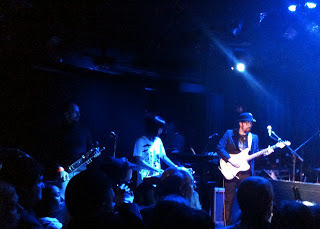

Plastic Ono Band and Others @ Le Poisson Rouge, 29 March 2011
On the following Tuesday, an historical event took place at Le Poisson Rouge. Sean Ono Lennon had put together an amazing program for a Japan benefit concert. We arrived at the venue around 9:30 pm and the queue was literally around the corner from Bleecker Street down Thompson Street. Luckily the night was not particularly cold, as we waited in line until the doors opened at 10:30 pm. The crowd was very mixed, but many were middle aged and looked like they had a history of listening to rock. All the tables and chairs had been removed and we crowded around the slightly elevated stage. The floor was already flowing with beer, as someone had dropped a pint. We took our place close to a rowdy group of rather rough looking lesbians.
The music started when Miho Hattori and Yuka Honda climbed on the stage. The two Japanese woman form the band Cibo Matto, which clearly has a large following of its own. I understand very well, as their music is charming and intelligent despite being essentially produced by electronic keyboards by Yuka over which Miho sings. After two songs played by the duo the stage was suddenly crowded by musicians, including Yuko Araki who sat behind the drum kit, two horn players, a guitarist and Sean Lennon on bass. Understandably the sound expanded and the rhythms became funkier. A somewhat silly looking male singer whose name eluded me joined Miho in a flowing version of the Bossa Nova classic 'Águas de Março.' After a few intensive pieces in which the horns provided funky riffs and the interplay between bass and drums worked, Cibo Matto and their entourage left the stage.
After a short break, the house erupted, as Patti Smith entered the stage. Her set was entirely acoustic, except for the electric bass played by Tony Shanahan (during the concert, the bass was passed around and the two guitarists also took turns playing it, while Shanahan grabbed a guitar or sat behind the piano), and she took the audience by her sheer charisma and the amazing musical quality of the performance. The lanky Lenny Kaye, with his long hair flowing to his shoulders, played some exquisite solos on the acoustic guitar which were some of the most beautiful moments of the evening. Patti chatted with the audience and appeared to be in a good mood, although she did attempt to block the lenses of some of the more intrusive photographers next to the stage. The whole performance was thrilling and I had tears streaming down my cheeks when Patti and her crew performed a magical version of 'Ghost Dance' dedicated to the people of Japan: "We shall live again."
Shortly after midnight, Sean Lennon announced that his mother, Yoko Ono, had entered the premises and right at that moment the diminutive lady dressed in black and donning a hat and large sunglasses perched on her nose climbed on the stage. That is when the real party began, with a new version of Plastic Ono Band led by Sean setting the tempo. The band was extended, with three guitars (including Sean and Shimmy Hirotaka Shimizu), keyboards, drums and trumpet. Time has not mellowed Yoko who started—and ended—the show with her trademark wails and screams. Throughout the night she jumped around the stage energetically, betraying her age: in February, Yoko Ono had just turned 78! Apart from directing the music, Sean played some of the most inspired guitar solos of the evening. Given that women so often in rock music have been relegated to the role of singers and dancers, it was very satisfying to see three highly professional female musicians solidifying the backbone of the band: tiny Yuko Araki whose tight beats kept the music rolling; the tall supermodel looking bassist who excelled in particular in some of the slower numbers where her musicality came through best; and Yuka Honda handling the keyboards.
As the night progressed, more guests climbed on the stage. The most prominent of them was Lou Reed. At mere 69, he should have been a real spring chicken compared with the evening's leading lady, but Reed appeared stiff and unsteady in his walking. He performed one long number with the band, a heavy rolling rock song, egging the little drummer girl to beat the cans ever harder. A man in the audience next to me said, incredulously, "I can't believe that these two are both together on stage!" I don't know whether this had ever happened before, but it was indeed historical to have Yoko Ono, Lou Reed and Patti Smith all in one concert! Another guest star was Antony who sang a number of duets with Yoko Ono. The large man with long hair and a baby face sang with a sweet voice and the entire impression was quite a contrast to the older star of the night.
The evening culminated in an extended version of 'Give Peace a Chance' during which most of the musicians who had performed during the evening returned on the stage. Sean Lennon standing next to his mother led them into the iconic song made famous by his father. Miho Hattori took the lead during the second verse until the others—and the audience—joined in. At 01:30 am as the concert wound to a close, we all felt the warmth and love channeled by the music to the people in Japan.
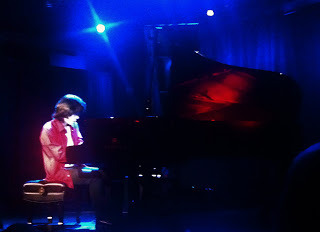
Taka Kigawa @ Le Poisson Rouge, 2 April 2011
When we returned to Le Poisson Rouge later in the same week, the place had been restored to its normal setting with tightly packed tables. The waitresses were cruising between them while we settled at a table in the second row in front of the stage. We were early and had time for a light meal before the show.
I used the word "show" intentionally, as that is what was in store for us. Taka Kigawa is a classical musician who plays the music as the composers meant it to be played without any tricks or gimmicks. But his interpretations are strong and engaging—and he communicates with the audience. He talked about the concert and commented on the pieces in between. Dressed in an open red shirt and black jeans, his long dark hair covering part of his face, Taka looked more like a rock musician than a classical pianist. All of this is why he has created a following that tonight sold out the large space. For tonight, Taka had put together an extraordinary program that would captivate everyone in the room. And as he would explain, there was a logic behind every piece that he had placed on the program. Obviously, much of the music would be Japanese, but those pieces that were not all had a reason to be included.
The concert started with two contemporary pieces by Japanese composer: 'atardecer/a...retraced' by Hiroya Miura and 'Crystalline' by Karen Tanaka. Taka is a specialist in contemporary music and plays it forcefully and with amazing concentration. However, on this emotional evening it was important to connect with everyone in the audience. This happened next when Taka played 'Images, Book I' by Debussy, with its three parts: 'Reflets dans l'eau,' 'Hommage à Rameau,' and 'Mouvement.' These lovely pieces demonstrated Taka's fluency in Debussy's language and the fluidity of especially his left hand. This was followed by two works by Chopin, 'Prelude in C-sharp minor, Op. 45' and the wonderful 'Ballade No. 4 in F minor, Op. 52,' Chopin's last, which Taka interpreted with incredible dynamism and emotion, earning him a huge ovation from the audience. Speaking about these choices, Taka explained how Chopin, while living in Paris, never forgot about and was always concerned about his home country of Poland, implying a similar feeling inside of him regarding Japan.
Next Kigawa inserted three more pieces by Japanese contemporary composers: 'Rain Tree Sketch II (In Memoriam Olivier Messiaen)' by Toru Takemitsu; a short piece, like the title implies, by Toshio Hosokawa, 'Haiku for Pierre Boulez,' and 'Joule' by Dai Fujikura, which Taka had premiered in the USA in January 2010.
The rest of the concert consisted of guaranteed crowd pleasers that Taka Kigawa played with unusual flair. Stravinsky's 'Trois Mouvements de Petrouchka,' derived from the ballet and transcribed for solo piano by the composer himself, in Taka's performance was simply incredible. The rhythm, the power, the energy just overwhelmed the audience who exploded in applause and cheers. The pianist came to the edge of the stage to take a bow after the piece, which could have been the grand finale for the concert. But he remembered having scheduled one more number in the program, Ravel's lovely 'Pavane pour une infante défunte.' The exquisite and pensive piece brought the thoughts back to the sadness of the situation in Japan.
Inspired by the cause and the enthusiasm of the audience, Taka took not one, but four encores, the highlight of which was Debussy's 'L'isle joyeuse,' an obvious reference to what the pianist—and we all—hope that Japan will once again be in the not too distant future.
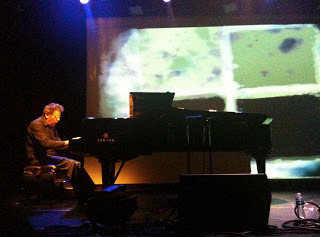
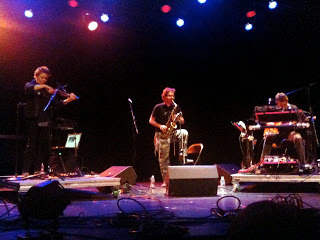
Concert for Japan @ The Japan Society, 9 April 2011
The Japan Society had put up a nonstop musical program that lasted for 12 straight hours on this Saturday. Finally, after a long and cold winter there was spring in the air and the sun was shining from a blue sky as Yoko and I approached the Society's headquarters in front of Dag Hammarsköljd Park in Midtown. There was a large crowd gathered on the street and in the park to listen to a Taiko drum performance outside of the entrance to the premises. There were also vendors selling Japanese food from several stalls, proceeds from which would be donated to the earthquake relief fund. The day's program alternated between free concerts of both Japanese traditional music and Western classical music, with two sold-out 'Gala Blocks' with reserved seating and big ticket items. We heard performances by Sadahiro Kakitani on solo ryuteki; Masayo Ishigure with a large group of koto, shamisen and shakuhachi players; James Nyoraku Schlefer playing his shakuhachi both solo and in group; and Yumi Kurosawa, whose piece on a 20-string koto impressed us.
For us the main attraction of the day was the first of the Gala Blocks, which featured Philip Glass. While we have often heard his music played in concerts in several cities, it was the first time ever to witness the composer himself behind the piano playing his own music. There was excitement in the air as we took our seats in the middle of the second row. The concert started with a performance in which Hal Willner read poetry by Allen Ginsberg accompanied by Philip Glass. Both of the performers had personally known Ginsberg and the jolly Willner explained the context of the poems that had been written over a lengthy period of time from the 1950s to the 1970s. There were some powerful images (and some very amusing ones, too) conjured up by the poems (note to self: reacquaint yourself with Ginsberg's works) and the pianist followed and strengthened the moods expertly.
Musically, however, what followed was more interesting. Philip Glass played against a film by Harry Smith, 'Early Abstractions' from 1946. I was not familiar with Smith, but according to Hal Wilner he was one of the greatest creative geniuses of the 20th Century, creating films and other works, including an anthology of American music, while never gaining wide recognition. As the abstract pictures moved on the large screen behind the piano, Philip Glass created an equally hectic music through his trademark fast and repetitive motifs that flowed into the hall seamlessly mixing with the visual media.
The final part of the concert was a 20-minute collective creation by three unorthodox features of New York's art scene: John Zorn, Laurie Anderson and Lou Reed. Zorn with his alto saxophone was flanked on both sides by arrays of electronics associated with Anderson and Reed. The latter took a very different role today from his recent rocker performance with the Plastic Ono Band. This was experimental music in which his contributions were through innovative effects on guitar and other electronics. The piece was loosely structured around segments and motifs but most of the playing appeared improvised. Laurie Anderson alternated between solos and accompanying effects on her electric violin. John Zorn blew into his alto at times lyrically just to be followed by aggressive bursts of raw energy as the piece grew in intensity. The culmination was when the trio was joined on stage by a Japanese Taiko player who beat thunderously into the large drum towards the final shock and awe of the music.
The above constitutes just a sample of all great (and some less so) music played to benefit the victims of the earthquake and tsunami that struck Northeastern Japan in March. It is wonderful to see all the empathy and support for the people on the other side of the world facing an unimaginable challenge to recover from the loss of families and loved ones and to start rebuilding the nation from the rubble. But this will not be the first time Japan raises from destruction. I do believe in the resilience of the nation.



Tenri Gagaku @ Tenri Cultural Institute, 11 March 2011
Gagaku—literally translated as 'elegant music'—is the oldest form of orchestral music that has survived continuously in the world and Tenri Gagaku Music Society is arguably (but then again, I might be biased) the best gagaku group outside of Japan. The music has its roots in the Silk Road period during which gagaku-like music was widely played in various parts of Asia, ranging from China to Southeast Asia. From the Tang Dynasty (AD 618-907) court in China it traveled east and landed in the Japanese islands via the Korean peninsula. In its new home, Gagaku was refined over centuries and passed down through generations of court musicians who belonged to hereditary guilds. While Gagaku has disappeared from countries in continental Asia, in Japan it was played in the homes of the military aristocracy and later preserved as living tradition in the ceremonies of the Imperial family.
The instrumentation used in gagaku today consists of a number of wind, string and percussion instruments, such as the ryuteki, hichiriki (a kind of double-reed oboe with a nasal tone), sho (a mouth organ), the biwa lute, the koto zither, and various drums, the kakko (small drum), shoko (metallic percussion) and taiko (large drum). Gagaku has a quality to it that sounds odd to the unaccustomed ear, but it definitely grows on you when you listen to it more.
On this evening Tenri Gagaku played a set of slow court pieces, starting with 'Etenraku.' This is probably the most well-known piece in the gagaku repertoire. It has a simple but catchy melody played alternately by hichiriki and ryuteki. Gagaku as music is monophonic, meaning that the melodies are played in unison by all instruments. The only real harmonies are provided by the sho, which provides a kind of solid mat of sound to the music (think harmonium in Indian traditional music).
The last piece of the concert was a dance number, bugaku, performed by Tazuko Ikedo dressed in a heavy and colorfully decorated costume. This was Tazuko's last performance before returning to Japan after several years in New York, so it was not to be missed. Her slow and deliberate movements to the plodding music produced a somewhat hypnotic mood that definitely captivated the audience of some 100 people who had crowded into the TCI hall. Gagaku and bugaku are a total experience that provide a feast for both the visual and auditory senses.




Concert for Japan @ Tenri Cultural Institute, 27 March 2011
Some two weeks later another Concert for Japan took place at TCI, this time featuring some of the foremost artists specializing in traditional Japanese music in New York. This concert was particularly precious for me, as it featured three shakuhachi masters: James Nyoraku Schlefer, Ronnie Nyogetsu Reishin Seldin and Ralph Samuelson. The concert started with 'Banshiki,' a tune belonging to the Meian Honkyoku tradition. The three masters were joined on stage with five shakuhachi students from the Tenri Cultural Institute. Clearly, 'Banshiki' was a tune that the students had to study and the group produced a decent version of the piece played on eight flutes that were only slightly out of tune. Some of the three men and two women were following closer in the footsteps of their teachers than others.
The concert also highlighted the versatility of the instrument to reflect the character of not only the music but equally the musicians. The temperaments of the three artists could not be more different and it was very interesting—and pleasurable—to observe how three players who are each trained in Japanese musical tradition and have reached the top levels in their chosen instrument could produce such differing artistic impressions. After the initial tune, the first concert performance was 'Haru no Umi' (or 'The Sea in Spring') featuring Nyoraku together with Masayo Ishigure, a masterful player of koto. 'Haru no Umi' is not a traditional Honkyaku piece, but rather a modern number composed by Michio Miyagi. It features lively dialogue between the two traditional instruments played in a not so traditional manner. The main theme of the composition is lovely and the variations indeed bring to mind the fickleness of the sea in springtime. It requires considerable skill from both instrumentalists and James played his part so smooth and clean that one could imagine listening to a Western flute instead of its bamboo ancestor.
'Jinbo Sanya' in the hands of Nyogetsu was an entirely different affair. The big man approaches shakuhachi from its original Buddhist perspective and had chosen this other Meian Honkyoku piece as his first solo number of the evening. The tune is haunting and Nyogetsu's interpretation used the full range of possibilities that the simple five-holed tube offers. The way he bent the tones using different techniques involving breathing, fingering, movement of lips, blowing angle and neck twists (known as kubi-furi, this is an essential, but hard to master technique for shakuhachi) produced remarkable sounds and effects that transported the listener to a medieval monastery in the misty mountains of Japan where the spirits of generations of Buddhist monks still linger.
Samuelson's first solo number was also a Honkyoku piece, but from a somewhat different tradition. The song entitled 'Choshi' was accompanied by the dancer Sachiyo Ito whose slow and sparse movements mirrored the music. Wearing a white kimono covered with a thin red coat, she moved deliberately with two fans in her hands to emphasize her choreography.
The first part of the concert ended with a koto solo by Masayo. It was 'Asa no Uta' or 'Morning Song' composed by her own teacher, Tadao Sawai. True to Sawai's style, this piece emphasized rapid movements and complex arpeggios. It was a koto player's delight, demonstrating virtuosity.
After the intermission, the three shakuhachi players returned each playing a solo piece. Nyoraku again started the set with a non-traditional tune, 'Ichijo' by Seiho Kinea. He explained to the audience in his jovial manner how the composer—a shamisen player who composed plenty of music for all Japanese instruments—had composed this tune in shock after a dear friend had "just dropped dead" after a pleasant evening they had spent together. The piece, in English 'Immutability,' conveyed the unpredictability of life and was therefore suitable for the occasion. I was not familiar with the composer, let alone the piece itself, but this would change after I heard the wonderful music. James was again smooth and perfect in his playing, but this time the song itself contained elements that were specifically shakuhachi-style, rather than any other flute. It was to me the highlight of the evening.
Ralph followed with a Honkyoku from the Kinko Ryu school, entitled 'Kyo Reibo.' Standing against the white wall and pieces of contemporary art Ralph, as usual dressed all in black, provided a stark contrast that suited the austerity of the song. His performance was less flashy or decorated than those of his peers, but it was deep, sincere and moving.
Nyogetsu returned with a jinashi shakuhachi that was longer than a regular shakuhachi and had a lower range. His final piece was another Meian Honkyoku with the title 'Futaiken Reibo.' The deep tonality of the slow moving tune resonated in the room, which has acoustics as if made for the sound of the flute.
The evening ended with a ritual: 'Chanting from the Heart' created by Sachiyo Ito. It involved Buddhist chants, dance movement and ringing of a traditional bell. Ito was this time dressed in an all white and light grey outfit. She was assisted by three younger ladies—Keiko Ehara, Hazuki Honma and Yukiko Yamamoto—all dressed in black trousers and shirts. One had the role of sitting on her knees throughout the performance, still and with a blank face, except when it was her turn to sound the large brass bell in front of her. As a final, all audience was invited to join in a walking meditation following the lead dancer.



Plastic Ono Band and Others @ Le Poisson Rouge, 29 March 2011
On the following Tuesday, an historical event took place at Le Poisson Rouge. Sean Ono Lennon had put together an amazing program for a Japan benefit concert. We arrived at the venue around 9:30 pm and the queue was literally around the corner from Bleecker Street down Thompson Street. Luckily the night was not particularly cold, as we waited in line until the doors opened at 10:30 pm. The crowd was very mixed, but many were middle aged and looked like they had a history of listening to rock. All the tables and chairs had been removed and we crowded around the slightly elevated stage. The floor was already flowing with beer, as someone had dropped a pint. We took our place close to a rowdy group of rather rough looking lesbians.
The music started when Miho Hattori and Yuka Honda climbed on the stage. The two Japanese woman form the band Cibo Matto, which clearly has a large following of its own. I understand very well, as their music is charming and intelligent despite being essentially produced by electronic keyboards by Yuka over which Miho sings. After two songs played by the duo the stage was suddenly crowded by musicians, including Yuko Araki who sat behind the drum kit, two horn players, a guitarist and Sean Lennon on bass. Understandably the sound expanded and the rhythms became funkier. A somewhat silly looking male singer whose name eluded me joined Miho in a flowing version of the Bossa Nova classic 'Águas de Março.' After a few intensive pieces in which the horns provided funky riffs and the interplay between bass and drums worked, Cibo Matto and their entourage left the stage.
After a short break, the house erupted, as Patti Smith entered the stage. Her set was entirely acoustic, except for the electric bass played by Tony Shanahan (during the concert, the bass was passed around and the two guitarists also took turns playing it, while Shanahan grabbed a guitar or sat behind the piano), and she took the audience by her sheer charisma and the amazing musical quality of the performance. The lanky Lenny Kaye, with his long hair flowing to his shoulders, played some exquisite solos on the acoustic guitar which were some of the most beautiful moments of the evening. Patti chatted with the audience and appeared to be in a good mood, although she did attempt to block the lenses of some of the more intrusive photographers next to the stage. The whole performance was thrilling and I had tears streaming down my cheeks when Patti and her crew performed a magical version of 'Ghost Dance' dedicated to the people of Japan: "We shall live again."
Shortly after midnight, Sean Lennon announced that his mother, Yoko Ono, had entered the premises and right at that moment the diminutive lady dressed in black and donning a hat and large sunglasses perched on her nose climbed on the stage. That is when the real party began, with a new version of Plastic Ono Band led by Sean setting the tempo. The band was extended, with three guitars (including Sean and Shimmy Hirotaka Shimizu), keyboards, drums and trumpet. Time has not mellowed Yoko who started—and ended—the show with her trademark wails and screams. Throughout the night she jumped around the stage energetically, betraying her age: in February, Yoko Ono had just turned 78! Apart from directing the music, Sean played some of the most inspired guitar solos of the evening. Given that women so often in rock music have been relegated to the role of singers and dancers, it was very satisfying to see three highly professional female musicians solidifying the backbone of the band: tiny Yuko Araki whose tight beats kept the music rolling; the tall supermodel looking bassist who excelled in particular in some of the slower numbers where her musicality came through best; and Yuka Honda handling the keyboards.
As the night progressed, more guests climbed on the stage. The most prominent of them was Lou Reed. At mere 69, he should have been a real spring chicken compared with the evening's leading lady, but Reed appeared stiff and unsteady in his walking. He performed one long number with the band, a heavy rolling rock song, egging the little drummer girl to beat the cans ever harder. A man in the audience next to me said, incredulously, "I can't believe that these two are both together on stage!" I don't know whether this had ever happened before, but it was indeed historical to have Yoko Ono, Lou Reed and Patti Smith all in one concert! Another guest star was Antony who sang a number of duets with Yoko Ono. The large man with long hair and a baby face sang with a sweet voice and the entire impression was quite a contrast to the older star of the night.
The evening culminated in an extended version of 'Give Peace a Chance' during which most of the musicians who had performed during the evening returned on the stage. Sean Lennon standing next to his mother led them into the iconic song made famous by his father. Miho Hattori took the lead during the second verse until the others—and the audience—joined in. At 01:30 am as the concert wound to a close, we all felt the warmth and love channeled by the music to the people in Japan.

Taka Kigawa @ Le Poisson Rouge, 2 April 2011
When we returned to Le Poisson Rouge later in the same week, the place had been restored to its normal setting with tightly packed tables. The waitresses were cruising between them while we settled at a table in the second row in front of the stage. We were early and had time for a light meal before the show.
I used the word "show" intentionally, as that is what was in store for us. Taka Kigawa is a classical musician who plays the music as the composers meant it to be played without any tricks or gimmicks. But his interpretations are strong and engaging—and he communicates with the audience. He talked about the concert and commented on the pieces in between. Dressed in an open red shirt and black jeans, his long dark hair covering part of his face, Taka looked more like a rock musician than a classical pianist. All of this is why he has created a following that tonight sold out the large space. For tonight, Taka had put together an extraordinary program that would captivate everyone in the room. And as he would explain, there was a logic behind every piece that he had placed on the program. Obviously, much of the music would be Japanese, but those pieces that were not all had a reason to be included.
The concert started with two contemporary pieces by Japanese composer: 'atardecer/a...retraced' by Hiroya Miura and 'Crystalline' by Karen Tanaka. Taka is a specialist in contemporary music and plays it forcefully and with amazing concentration. However, on this emotional evening it was important to connect with everyone in the audience. This happened next when Taka played 'Images, Book I' by Debussy, with its three parts: 'Reflets dans l'eau,' 'Hommage à Rameau,' and 'Mouvement.' These lovely pieces demonstrated Taka's fluency in Debussy's language and the fluidity of especially his left hand. This was followed by two works by Chopin, 'Prelude in C-sharp minor, Op. 45' and the wonderful 'Ballade No. 4 in F minor, Op. 52,' Chopin's last, which Taka interpreted with incredible dynamism and emotion, earning him a huge ovation from the audience. Speaking about these choices, Taka explained how Chopin, while living in Paris, never forgot about and was always concerned about his home country of Poland, implying a similar feeling inside of him regarding Japan.
Next Kigawa inserted three more pieces by Japanese contemporary composers: 'Rain Tree Sketch II (In Memoriam Olivier Messiaen)' by Toru Takemitsu; a short piece, like the title implies, by Toshio Hosokawa, 'Haiku for Pierre Boulez,' and 'Joule' by Dai Fujikura, which Taka had premiered in the USA in January 2010.
The rest of the concert consisted of guaranteed crowd pleasers that Taka Kigawa played with unusual flair. Stravinsky's 'Trois Mouvements de Petrouchka,' derived from the ballet and transcribed for solo piano by the composer himself, in Taka's performance was simply incredible. The rhythm, the power, the energy just overwhelmed the audience who exploded in applause and cheers. The pianist came to the edge of the stage to take a bow after the piece, which could have been the grand finale for the concert. But he remembered having scheduled one more number in the program, Ravel's lovely 'Pavane pour une infante défunte.' The exquisite and pensive piece brought the thoughts back to the sadness of the situation in Japan.
Inspired by the cause and the enthusiasm of the audience, Taka took not one, but four encores, the highlight of which was Debussy's 'L'isle joyeuse,' an obvious reference to what the pianist—and we all—hope that Japan will once again be in the not too distant future.


Concert for Japan @ The Japan Society, 9 April 2011
The Japan Society had put up a nonstop musical program that lasted for 12 straight hours on this Saturday. Finally, after a long and cold winter there was spring in the air and the sun was shining from a blue sky as Yoko and I approached the Society's headquarters in front of Dag Hammarsköljd Park in Midtown. There was a large crowd gathered on the street and in the park to listen to a Taiko drum performance outside of the entrance to the premises. There were also vendors selling Japanese food from several stalls, proceeds from which would be donated to the earthquake relief fund. The day's program alternated between free concerts of both Japanese traditional music and Western classical music, with two sold-out 'Gala Blocks' with reserved seating and big ticket items. We heard performances by Sadahiro Kakitani on solo ryuteki; Masayo Ishigure with a large group of koto, shamisen and shakuhachi players; James Nyoraku Schlefer playing his shakuhachi both solo and in group; and Yumi Kurosawa, whose piece on a 20-string koto impressed us.
For us the main attraction of the day was the first of the Gala Blocks, which featured Philip Glass. While we have often heard his music played in concerts in several cities, it was the first time ever to witness the composer himself behind the piano playing his own music. There was excitement in the air as we took our seats in the middle of the second row. The concert started with a performance in which Hal Willner read poetry by Allen Ginsberg accompanied by Philip Glass. Both of the performers had personally known Ginsberg and the jolly Willner explained the context of the poems that had been written over a lengthy period of time from the 1950s to the 1970s. There were some powerful images (and some very amusing ones, too) conjured up by the poems (note to self: reacquaint yourself with Ginsberg's works) and the pianist followed and strengthened the moods expertly.
Musically, however, what followed was more interesting. Philip Glass played against a film by Harry Smith, 'Early Abstractions' from 1946. I was not familiar with Smith, but according to Hal Wilner he was one of the greatest creative geniuses of the 20th Century, creating films and other works, including an anthology of American music, while never gaining wide recognition. As the abstract pictures moved on the large screen behind the piano, Philip Glass created an equally hectic music through his trademark fast and repetitive motifs that flowed into the hall seamlessly mixing with the visual media.
The final part of the concert was a 20-minute collective creation by three unorthodox features of New York's art scene: John Zorn, Laurie Anderson and Lou Reed. Zorn with his alto saxophone was flanked on both sides by arrays of electronics associated with Anderson and Reed. The latter took a very different role today from his recent rocker performance with the Plastic Ono Band. This was experimental music in which his contributions were through innovative effects on guitar and other electronics. The piece was loosely structured around segments and motifs but most of the playing appeared improvised. Laurie Anderson alternated between solos and accompanying effects on her electric violin. John Zorn blew into his alto at times lyrically just to be followed by aggressive bursts of raw energy as the piece grew in intensity. The culmination was when the trio was joined on stage by a Japanese Taiko player who beat thunderously into the large drum towards the final shock and awe of the music.
The above constitutes just a sample of all great (and some less so) music played to benefit the victims of the earthquake and tsunami that struck Northeastern Japan in March. It is wonderful to see all the empathy and support for the people on the other side of the world facing an unimaginable challenge to recover from the loss of families and loved ones and to start rebuilding the nation from the rubble. But this will not be the first time Japan raises from destruction. I do believe in the resilience of the nation.
Published on April 12, 2011 07:08
March 13, 2011
Massive earthquake and tsunami devastate northeastern Japan


On Friday, 11 March 2011, at 14:46 hrs, disaster struck Japan. One of the largest earthquakes on record struck just off the Pacific coast of the island nation. The shaking lasted for a full five minutes—a terrifyingly long time when one entirely loses orientation, may not be able to stand up, with everything falling down around you, walls and houses crumbling, the rumble of the earth drowning all other sounds—triggering a massive tsunami. Because the epicentre was so close to the coast, there was hardly any warning or time to evacuate. The first waves reached the Sanriku coast within ten minutes completely overrunning the towns and ports leaving total destruction in their wake.
The worst affected areas were in the northeast of the main island, Honshu. The prefectures of Miyagi and Iwate bore the brunt of the force. Iwate is the home area of my wife's family where we have also planned to return eventually to live in the lovely valleys between forested mountains. It has been considered the most stable region of Japan, least at risk from earthquakes. There was no way to get in touch with relatives and friends as, of course, all communications were cut. Whatever communications infrastructure was left standing was immediately overstretched as millions of people tried to contact their loved ones. We were left helplessly glued to TV Japan that broadcast horrifying live footage from the disaster zones. Initial films were mostly from Tokyo with some footage shot from helicopters flying over the coast. The northern Tohoku region where Miyagi, Iwate and Aomori Prefectures are located was cut off the rest of the world.
Tohoku's largest city, Sendai, situated on higher ground and away from the sea was largely spared from major damage. The city airport closer to the coast was not so lucky. Cameras from there showed the massive wave sweeping slowly across the runways. Large jet planes floated away like toy models. Aerial shots from the close by mountain areas showed huge liquefaction of the soil, again in slow motion, wiping away entire villages, houses crumbling and being washed down the slopes into the sea. The destruction there was complete.
The magnitude of the earthquake and the ensuing tsunami entirely overwhelmed all preparedness plans in Japan, probably the best prepared country in the world. The infrastructure was destroyed to such an extent that no rescue teams could reach the area. Places that we so well know were no more. Kesennuma, a major port city on the Sanriku coast in Miyagi, was gone. First the tsunami swept across the entire low lying valley. When it receded, fires that ensued as gas pipelines were destroyed finished the job burning down the entire old wooden town. Kesennuma had been the site of a large fishing port and the centre of the Pacific shark fisheries just because of the shape of its natural harbour. Now this same geographic advantage had provided the tsunami a perfect entrance to the harbour bowl allowing the water to rise unhindered into the city. A couple of years ago we spent some lovely time in Kesennuma enjoying its fabulous seafood. Yoko's old high school geography teacher, Abe Take Sensei, took us to his favourite restaurant and was slightly upset with me for ordering simple grilled fish in this haven of amazing specialities from the sea. Abe Take Sensei himself ordered shark's heart to accompany his beer. We all feasted on the weird looking sunfish from deep under the ocean. Now, none of these places would no longer be in existence.
Luckily, Yoko's family resides mostly further inland, in and around Oshu-shi straight north from Sendai halfway to Morioka, the second largest city in Tohoku. Their towns—Mizusawa, Esashi Maesawa, Koromokawa—were at least out of the reach of the tsunami. Late on Friday afternoon when it was already night in Japan we finally received a brief text message from an aunt, Shigeyo. She had been in touch with Yoko's mother Tomoko. Both elderly ladies were fine, but there was no electricity and no water. The entire area was in pitch darkness and it was cold. Snow was falling on the ravaged land. Nevertheless, it was a huge relief to hear from the family.
Another major worry, however, remained. Yoko's 15 year old nephew Hiromichi and his mother Miho lived in Hakodate, a coastal city on the northern island of Hokkaido and there were reports about the tsunami having soaked the city.
I was scheduled to fly into Japan in the beginning of the coming week in connection with an Asian business trip, but I cancelled the trip. There was no sense in going and adding to the chaos and possibly hampering transportation of relief workers and supplies. Some economists were already calculating how such dedication of port facilities to relief needs would be blocking Japan's exports. Other economists were estimating how the reconstruction that follows might actually provide a boost to Japanese manufacturing and economy. Economists are a different breed. No one was able to estimate the human death toll from the disaster, but there were reports of 200-300 bodies floating in the water on Miyagi coast, whom nobody was able to reach. But for the economists, there were more important and urgent calculations to be made.
On Saturday there was more live footage from Sanriku. Rikuzentakada, Ofunato, Kamaishi and other towns had been completely wiped out. It was impossible to imagine how one might even begin clearing the debris and start reconstruction. Only some sturdier concrete buildings stood amongst the rubble. Some lucky people had managed to reach their rooftops or run up the slopes to be saved only to observe the annihilation of their homes. Many old people didn't make it. In Kamaishi there was a home for disabled children. It seems it was gone with the waves.
In January 1995, a strong earthquake hit the western Japanese port city of Kobe and its surroundings. It was the worst disaster in Japan for decades before that. I was then in Osaka, just some 80 kilometres from the worst affected areas. I was woken up in my small 10th floor hotel room in the early morning hours. The shaking was intense but much shorter and less powerful than this time. But it was the scariest moment that I had ever experienced—before or after. On the following day I managed to get to Kobe to observe the damage together with colleagues who were world's leading earthquake experts. They were all shocked. Tsuneo Katayama, then earthquake engineering professor at Tokyo University and a top authority on the topic, estimated in the morning that several hundred people may have perished. In reality, the final count was more than 6,000 dead. The trust in Japanese engineering solutions and earthquake preparedness had bred complacency. It turned out to be mistaken, as large buildings pancaked, elevated expressways broke up and crashed, fires engulfed older neighbourhoods.
But the Great Hanshin Earthquake that destroyed Kobe was small compared with the current Miyagi-Iwate Earthquake. On Saturday night, the Japanese authorities adjusted the original estimates of the earthquake's magnitude upward to 9.0 on the Richter scale, making it one of the most powerful events ever experienced anywhere. Furthermore, the Great Hanshin Earthquake was relatively concentrated in a limited geographical area. While this time the main epicentre was off the coast in the northeast, earthquakes erupted throughout a huge area some 500 km long and 200 km wide running in parallel of the Honshu coastline. Even in Tokyo, the shaking had been at the level of 7.0 Richter.
On Saturday we finally got through to Yoko's mother. It was an incredible relief to hear my dear mother-in-law at the other end of a surprisingly clear phone line. True to her nature, Okaa-san (or mother as we call her) sounded upbeat. She too was very happy to talk to her daughter on the other side of the world. Somewhat against the odds, the rather flimsy home in Mizusawa was still standing and relatively undamaged.
As electricity and communications were slowly being restored, we managed to get in touch with the rest of the family. Everyone seemed to be accounted for. Miho told that the tsunami had completely soaked Hakodate with the streets flowing with 1-2 metres of water, cars and other loose items piling up in heaps where the waves threw them. But miraculously hardly any lives were lost. Akiko, a cousin who manages a Buddhist temple in Esashi after her late monk husband, reported that the graveyard on the slope had been destroyed, but that she was fine. So were the other cousins and relatives in Maesawa and Koromokawa. Akiko had slept the past two nights in her car. It was freezing.
Many other families were of course not so fortunate. Today, Sunday, there are still no firm figures on casualties, but it is likely that the death toll will exceed 10,000. Prime Minister Naoto Kan stated that this was the worst disaster Japan had faced since World War II. The National Broadcasting Company NHK is interviewing survivors. A man survived by swimming for almost 30 minutes in the freezing waters. His face was badly bruised and all his ribs were broken. An elderly woman had been riding in a car driven by her husband along the coast in Kamaishi when the tsunami hit. It lifted the tiny Japanese car 2 metres up a tree where it got stuck in a hook between branches, which saved her life. There she sat, soaked and frozen as snow was falling, until she was rescued and lifted up into a helicopter that transported her to a hospital. These were amongst the lucky people.
Then there is the issue of the nuclear power plants, which the resource-strapped Japan relies on for its energy needs. There were immediate reports that the coastal plant in Fukushima would become a radiation risk. Already on Friday, the government ordered an evacuation of people on a 3 kilometre radius from the plant. People within a 10 kilometre radius were supposed to stay inside and close the windows. That obviously assumed they still had some place to stay in. Also many people in the vicinity, especially old people, were not able to evacuate. On Saturday, there was an explosion in the plant and hundreds of people were exposed to radiation.
It further turned out that it was not only the Fukushima plant that was at risk. The Japanese nuclear plants—the best in the world and supposedly entirely secured against seismic risk—had not been prepared against quite this magnitude of an earthquake. A good friend of mine called from Vienna, Austria, where he works at the International Atomic Energy Agency (IAEA). I could hear he was upset with his engineer colleagues who had always underplayed any risks with nuclear energy. The problem is that nuclear plants, like other such systems, are designed to withstand incidents based on a calculation of historical risk. Cost-benefit calculations are made relating the investment needed to the likelihood of an incidence above a certain magnitude. How low the likelihood may ever be, when such an incident takes place, its impact is 100 percent.
As I write this, Tokyo Electric Power Company officials on TV are appealing to citizens to limit their electricity use, as facilities are not able to provide them sufficient current. This inconvenience pales in comparison with what may happen if the nuclear plants start blowing up.
Despite all this amazing damage and chaos, Japanese preparedness seems to be paying off and organizational effectiveness is facilitating early rescue and recovery efforts. Footage from centres where survivors have gathered shows people behaving calmly, keeping warm in groups around stoves, waiting in orderly lines to get water or reach a telephone that has been provided by the authorities. In Japan, people are self-disciplined and well educated. They do not riot or loot or start fighting with each other. One can only imagine what kind of consequences this kind of disaster could have in many other countries.
In the meantime, powerful aftershocks continue and the danger is far from over. According to the scientists, there is still a 70 percent probability for a 7.0 magnitude aftershock in the coming 3 days. We will continue monitoring the situation from a distance. Our thoughts and our hearts are with the people in Japan, family, friends and strangers alike.
Published on March 13, 2011 12:37
February 6, 2011
Mandala in New York
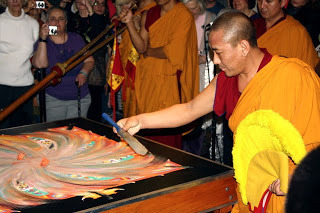
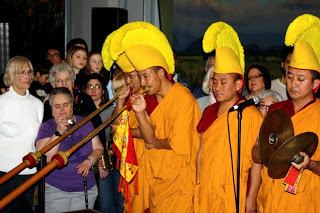
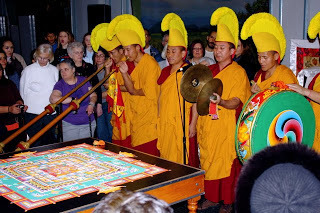
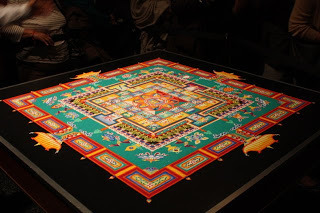
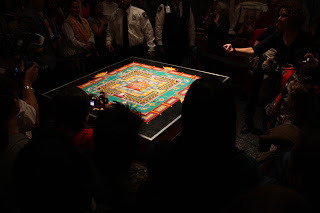
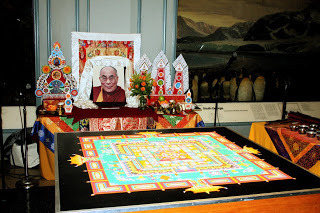
On the last Sunday of January the Buddhist monks destroyed the mandala they had constructed over the past several days in the American Museum of Natural History in New York. Mandalas have been found in many spiritual traditions, including Hindu and Buddhist, although the most famous ones are associated with Tibet. In Tantric Buddhist practice, these cosmic diagrams assist in inner spiritual development. Mandalas are created from a variety of materials and for a variety of purposes, meditation, healing and purification. The one in AMNH, like most of the Tibetan ones, had been made of sand and was a healing or medicine mandala. It was part of a series on 'Brain and the Tibetan Creative Mind' that the museum organized. It complemented the fascinating exhibition on Tibetan medical paintings, 'Body & Spirit,' curated by Laila Williamson, that had opened just before in the museum, as well as the scientific exhibition 'Brain: The Inside Story.'
The centrepiece itself was truly beautiful. The hall where it was placed was obscured in semi-darkness and the lights directed to the mandala lit it up so that the bright red, green and yellow of the sand painting literally shone. The beauty of the piece of art was breathtaking, even in the less than perfect setting. A picture of the Dalai Lama sat on a table behind the mandala and behind him were the museum's permanent dioramas of Antarctic nature complete with penguins. Himalaya in the Antarctica. The hall was also so crowded with people that the security guards had to shout and push them back so that the perimeter around the object of admiration was clear. They also tried to get people to circulate around the mandala in a clockwise movement, so that all and everyone would get a closer look at the work. "Keep on moving, perambulate! You don't need thirty photographs, ten is enough!," the guards kept on prodding the less than cooperative crowd. I heard the event coordinator, a tiny grey-haired Asian woman, say to one of the guards that their plan and organization were not perfect.
The monks who created the mandala came from two monasteries, including the Tashi Lhunpo Monastery in India. This inter-monastic cooperation in itself is quite rare. They had come to create and then destroy the mandala – a symbol of the impermanence of life and the futility of human effort –at AMNH to raise awareness of their culture, but also to raise support to the Tibetan cause.
After a lengthy thank you session during which – it seemed – half of the museum staff received long white scarves and a paper bag from the monks showing their gratitude (although this part of the event would have been better suited to a celebration behind closed doors, I thought it was still nice that the monks did not forget anyone, not even the security guards who got their uniformed necks wrapped in white), the spokesperson, a youngish monk with a round shaved head and eyeglasses, launched into a prolonged diatribe against the Chinese. He poured vitriol over the occupying Chinese who systematically suppressed religion and were responsible for the deaths of uncounted Tibetans. He explained how the Dalai Lama's entourage of only thousands of monks were the last holdout defending the old culture and religion in Dharamsala in India. This political message obviously sunk into the spiritually-inclined audience gathered here. They had heard Richard Gere and other celebrities explain this to them before. The truth, as always, is less black and white. The Chinese I have talked with over the years – academics, government officials, oversees expats, regular folks – have been invariably baffled about the strong resistance of the Tibetans to their efforts to bring them progress. The communist ideology is, of course, negatively disposed to religion, which it sees as backward, maintaining the oppressive feudal system. But the main motivation of the Chinese, I would argue, is to bring economic development to Tibet and they just can't understand why the locals don't embrace the inevitable march of progress and accept the necessary sacrifices, like destroying old neighbourhoods to make way for superior new concrete blocks or turning the sacred lake in Lhasa into an amusement park for the invading entrepreneurs from the east. The greatest crime of the Chinese in Tibet and elsewhere is gross cultural insensitivity and a criminal level of tone deafness to local sensibilities. Mind you, last month on a trip to New Delhi I discovered that the staff in the gym and spa I patronized were Tibetans. I talked with one of the ladies and she explained that she'd been to India for ten years and that it was virtually impossible for her to get a visa to go back and visit her homeland. So it is true that the Chinese government to whom internal security is paramount does also pose unacceptable and stupid restrictions on people. What security threat did this soft-spoken woman pose, I wondered. Perhaps the blissful massage she provided would be too calming, so that people would forget their duty to conquer the earth and turn natural resources into wealth by creating billions of trinkets that the world would buy.
Finally the ceremony itself was ready to begin. The bespectacled spokesman withdrew to the back as nine saffron-robed monks formed a line behind the mandala. They all placed high yellow felt hats on their shaved heads, their tops curving into a big hook. The leader started the chant in which the eight others would join. The leader displayed extraordinary skill in using his voice. At times he would recite the sutra at a very low pitch using his throat to create an otherworldly two-layered gurgling sound. At other times, the entire monks' choir got into a hypnotic chant that was paced to induce trance. In Tibet, chanting is an integral part of religious rituals and involve recitation of sacred texts or sutras. The chants are rhythmically complex and involve minutely executed changes in mood and tempo.
I observed the audience and saw that many people had their eyes closed, several of them clearly praying to whatever gods they had. Only an elderly Jewish man in front of me was restless. He had come to the event with his extended family (and I'm sure attending had not been his own idea), but the family was dispersed around the mandala in the dense crowd. The yarmulke and jeans wearing gent did not stay restful for more than ten seconds at a time. He was fidgeting and glancing around constantly. He tried to wave and make faces to his granddaughters on the other side of the stage (sensibly, the young girls ignored the silly grandfather). At one point when the chanting intensified into a rhythmic crescendo, the man started chanting his own syncopated counter-riffs while taking a few klezmer dance steps. Luckily for him, the rest of the audience seemed to be too absorbed in the beautiful ritual to take too much notice of his disrespectful distractions.
In the middle of the chanting at a particularly intense moment two of the monks blew into their long trumpets known as dungchen, while two of their colleagues crashed cymbals and beat on a large bass drum creating a majestic ruckus. One could only imagine how these sounds would soar above the Himalayas and echo from the walls of the mountains across green, fertile valleys inspiring awe in the farmers down in their fields. This mighty clamour was repeated towards the end before the chanting died and the monks removed their crooked headgear.
Then one of them approached the mandala and slowly circled it drawing lines across it with his hand: from south to north, from east to west, entering from the four gates on each side of the mandala. He then proceeded to stir the carefully arranged sand, the result of many days of painstaking work by the monks from two monasteries high in the Asian mountains, into colourful swirls before entirely destroying the patterns. The futility and impermanence of human endeavour. Grains of this sand were then distributed to the spectators in small plastic sachets, so we too now have a tiny piece of the mandala to enhance the peace of our home.
Published on February 06, 2011 10:48
December 30, 2010
Bali: People and Pollution in Paradise

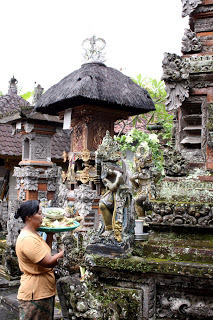
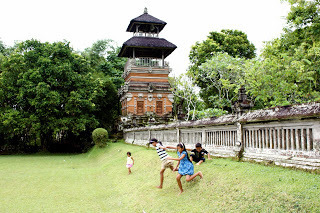
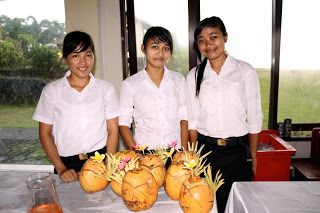
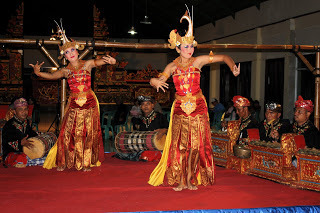
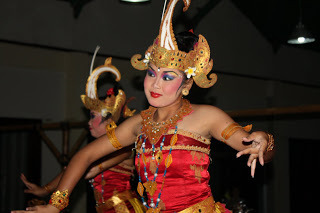
"It's Galungan and I'm very busy," Putri said as she was pouring me a drink. She works at the hotel where I was staying. It was already close to midnight and she would have a short night. Although she said she lived close by here in Nusa Dua, during the festival she would have to go to her parental village, which involves a 1.5 hour ride on her moped. And she will have to be ready to go to the temple to make offerings to ancestors with her family at 5:30 am. Galungan is a Hindu festival, closely related to Diwali, the festival of light celebrated in India. But Galungan – like Hinduism here in general – has a distinct Balinese twist. First, unlike the annual Diwali, Gadung is celebrated twice a year and celebrates the creation of the world. For Putri and many others like her employed in the booming commercial sector the traditional festival is a source of both devotion and stress. Tradition is alive and well on Bali.
ting."
Bali has the reputation of being as close to paradise as any place on earth. The mostly Hindu island in the world's largest Muslim nation is known for its temples, relaxing lifestyle, friendly people and beaches of white sand. But there are mounting pressures that threaten the paradise-like setting. A place whose charm so much depends on its beauty and clean nature is particularly vulnerable to environmental problems.
The most obvious pressure comes from the sheer number of people. The tiny island has some 3.5 million permanent inhabitants, making it one of the most densely populated places on the planet. This is particularly striking to me, as my own country of birth lies at the opposite end of the spectrum: Finland with sixty times the land area of Bali has just 5 million people. Of course, Bali's tropical climate and fertile soils have in the first place been able to support such a large and growing population, unlike the frigid conditions up north. Still, the place is increasingly crowded and despite the recent rapid urbanization it is overpopulated. As reported in The Jakarta Post (30 April 2010), according to Indonesian national standard, the maximum population to be supported in Bali in a sustainable manner would only be about 1.6 million people or less than half the current population.
The urban centres themselves present a slew of problems. With haphazard growth and inadequate infrastructure, pollution runs into the rivers and pristine places are transformed into townships. Denpasar, the capital, is now like a miniature Jakarta, crowded with people, cars, mopeds and pollution. The city has a distinct waste management problem that is acknowledged by Indonesian researchers and environmentalists. The city alone produces more than 1,500 m3 of garbage every day, rendering the city planners' beautification efforts futile. Other growing urban centres are quickly following in its destructive path.
Nusa Dua at the southern tip of the island is an ecosystem in itself. Developed for tourism, the area is built with self-sustaining hotel complexes complete with numerous restaurants, spas, pools and sporting facilities. The entire area is spotlessly clean, neat and well organized with straight roads and perfectly manicured lawns. The main shopping centre, Bali Collection, contains a complex of shops and restaurants where the prices are fixed to a level that would be far above affordable to locals used to viewing bargaining as a competitive, if good-humoured and friendly sport.
Despite this cleanliness, tourism is one of the greatest causes of strain to Bali's environment. Again, it's the sheer numbers of people visiting the island. There are 1.9 million visitors annually to the tiny island! The Balinese receive the visitors well and are very tolerant of their sometimes less than gracious ways. In fact, the locals are so tolerant that Indonesian Muslim terrorists bombed entertainment establishments in 2002 and 2005. The earlier bombing in Kuta killed 202 people, including 88 Australian tourists. This put a dent into Bali's reputation as a party destination and somewhat reduced its popularity among Australians and other Westerners. But whatever slack developed, it has been quickly taken over by others. Apart from the Japanese who have been there for a long time, Chinese tourists are increasingly visible, although most of them seem to be young couples or move only in small groups. What struck me in Nusa Dua was the number of Russians. The beach was crowded with shapely blonds trying to turn their colour darker in places where their tiny bikinis didn't cover the flesh. The men already tended to sport a naturally redder colour on their bellies, which they started to fill with the refreshing Bingtang or Bali Hai beers from an early hour.
Tourism is blamed for overcrowding the island and straining its environment. In an article with the website Bali Discovery (18 May 2009), the Executive Director of WALHI, an environmental watchdog, Agung Wardana in particular highlights the role of tourism in depleting Bali's precious water resources. He estimates that every hotel room adds around 3,000 litres to the daily consumption of water. And the golf courses that are converting agricultural land to artificial parks for the benefit of rich and spoiled visitors add another 3 million litres a day to the consumption. This can be contrasted with the average of only 200 litres per day used by the local Balinese. There have been well justified calls for limiting the number of tourists and the construction of new facilities to accommodate them.
My purpose for being here was attending an international meeting, so one afternoon my fellow participants and I embarked on a cultural tour heading towards the temples in Taman Ayun and Tanah Lot. We passed through the booming town of Kuta, first driving through the touristic area with its rows of bars, restaurants and shops; then moving to the more traditional quarters where the locals reside. Ayu, our talkative guide, pointed out the canal running in parallel to the street, suggesting that it would not be a good idea to take a dip there. "The town has grown so quickly and there's no sewage treatment. These canals used to be nice, actually," she commented.
Nevertheless, the town does not by any means give an impression of a slum. It all looks rather upbeat unlike many others elsewhere in the developing world (or the USA). Nobody has the time to loiter around, as everyone goes about their business. The Galungan decorations are everywhere. Tall decorated wooden poles line the streets and statues by the numerous temples have been dressed up in checkered black and white clothes – yin and yang – intended to ward off the evil.
Ayu whose name translates into 'beautiful' keeps up a running commentary on the history and culture of Bali, as well as the present we can observe as we drive on. Ayu is a rather tall and lively girl whose constant white smile does indeed make her live up to her name. Both Ayu and Putri at the hotel would dispel any preconceived notions of tiny, waif-like Indonesian girls, neither one being particularly petite or shy.
We continue further inland and see construction everywhere. "Corn to concrete," the observant Ayu remarks. Indeed, in the outskirts of Kuta farmland is incessantly being converted into buildings. But still every available plot in between has been dedicated to small rice paddies. Farmers still keep cows that roam freely in open spaces.
This land transformation – from agriculture and forest into cities, roads and, yes, hotels and golf courses – is one of the biggest problems affecting the future sustainability of the environment and even the economy of Bali. Apart from converting beautiful landscapes into sprawl, it negatively affects the ecological and water balance on the island. It even threatens food production. Every year, tracts of agricultural land is converted into non-agricultural uses.
It started to rain and the landscape turned dark. The traffic was really bad and we were barely moving forward. In the nearly two hours in the car we had gotten only half way where we wanted to go. Suddenly the driver had had enough and without saying a word decided to turn the vehicle around blocking the traffic further. We then headed back and found a roundabout route between agricultural fields where fewer drivers had wandered. Here the landscape was still serene with terraced paddies glistening wet. In spite of the rain that was getting heavier, some farmers were still working their fields. The hillsides were forested.
On the way, we made a stop at a private smaller place of worship at a traditional Balinese house in Baha Village. We caught the proprietor preparing candles and offerings to the deities. Dressed in a yellow blouse and a sarong, she went around from one shrine to the next, placing the candle and the offerings, then put her hands together in a silent prayer.
At the big temple at Taman Ayun the mood was dampened by the rain, but the hawkers along the parking lot beckoned us to shop for trinkets and soft drinks. No doubt, their business would have been better in less inclement weather. More and more busses brought in tourists as we entered. The temple complex is very impressive. Built in 1634 as the main temple of the historical Mengwi Kingdom, the area consists of a huge number of multilayered shrines known as Meru. In the middle yard there is a tower with wooden bells or Kulkul. The entire area is surrounded by a moat.
Wet and tired of sitting in the traffic in between the sights, we continued towards our final destination. Even Ayu was rather low key, only promising that the ride would not take long to reach Tanah Lot on the coast. The place turned out to be extraordinarily beautiful, the small temple of Tanah Lot being perched on a rock protruding into the Timor Sea. It has stood there facing the sometimes stormy (like now) sea since the 16th century when it was established by the Javanese priest Danghyan Nirartha. This was a spot from which to enjoy the sun setting in the west over the sea, but on this particular evening clouds obscured most of the daily spectacle. We were just happy to enjoy refreshing coconuts prepared by three sweet young ladies before settling in for a grilled seafood dinner containing fresh fish, lobster, prawns and mussels.
During the evening we were also treated to a delightful performance of traditional Balinese dance. The dancers in delicate outfits glittering with colour and gold performed elaborate dramas from history and mythology. The movements of their eyes are as important as the movement of other parts of the body. A skilful band of stone-faced musicians sitting on the floor behind their Gamelan instruments produced a hypnotic yet dynamic accompaniment to the dance. Later, we witnessed a performance unique to the Tanah Lot region. The music accompanied Barong, a story-telling dance about the fight between good and evil. Completely different from the Gamelan, the music reminded me more of the rituals seen in the South Pacific.
On a different night, I grabbed a taxi to Kuta in order to observe first hand the impacts of backpacking and party tourism on a local city. It was around 11 pm when the driver dropped me off at one end of the beach boulevard. The strip was quieter than I had thought, probably expecting to see a replica of some similar coastal towns in Thailand. This was not the case, at least yet. There were of course numerous bars lining the street, including the ubiquitous Hard Rock Cafe, but the scene was generally quite sedate. As I strolled along the waterfront, I was several times approached by local men offering young women for massage or hashish and marijuana – a particularly stupid proposition in a country where possession of drugs carries the death penalty. Most often, they only offered 'transportation', meaning a ride on the back of their light motorcycle. Nusa Dua was too far to make such offers attractive. Another thing that was conspicuous was the extensive construction that was going on even after midnight on this weekend night. New hotels were coming and traditional quarters were being erased to make space for them. Clearly, the local financiers and tourist industry were not paying heed to the warning calls about overcrowding the island or overextending its environment.
Bali is still beautiful and the Timor Sea surrounding it is still full of fish and accommodating to humans who wish to join them for a swim. Ample water is a key element of Bali's attraction. It is essential equally for the survival of the traditional way of life and agriculture and the tourism-based economy. One can only hope that the quest for money will not entirely spoil the basis of which life and the rich culture rely on. At least today, we can still enjoy the beauty and hospitality of Bali and its people to the soothing sounds of Gamelan.
Published on December 30, 2010 12:09
December 8, 2010
The Second World: Geopolitics vs. Globalization
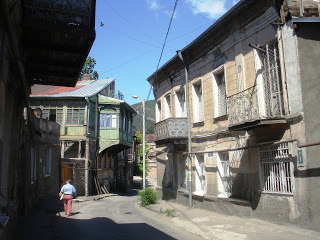
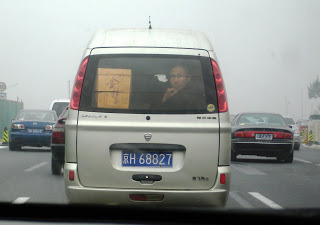


Geopolitics vs. globalization. Now that's an interesting juxtaposition and it's at the heart of the book The Second World: How Emerging Powers Are Redefining Competition in the Twenty-first Century by Parag Khanna. The focus of the book is fresh and delightfully geographical. Khanna, a senior fellow and program director at the New America Foundation, takes us on a whirlwind tour around the world hopping from one region to next focusing on the 'second world,' emerging countries that are no longer part of the third world but have not quite reached the first world status. The author's credible claim is that much of the future of the world will depend on what happens in these countries, many of which are now finding their place amongst the larger geopolitical scene. Geopolitics is the great game in which countries and especially the dominant powers vie for influence and advantage over others. Khanna sees globalization as a potential counterforce to geopolitics wherein the interconnectedness of the entire world makes it a safer place. He is no starry-eyed idealist who believes in an overpowering positive force of globalization. Geopolitics is alive and well there is no doubt it. Khanna also recognizes that the United States is no longer the sole superpower as it might have appeared at the end of the Cold War. In fact, he makes a convincing case that its star is fading. For the first time, we live in a tripolar world, with the US, the European Union and China making claims at being dominant powers, both regionally and on a global scale. This constellation and how these three powers interact with the second world is at the heart of the book.
Like a good regional geography, the book is organized in five sections along continental lines. The first part, entitled The West's East, focuses on the eastern periphery of Europe and the aspiring members of the EU. The second part, Affairs of the Heartland, covers the Eurasian landmass, Central Asia, which is now again the chessboard in a new Great Game, this time played by the three new dominant powers. The title of the third part, The End of the Monroe Doctrine, says it all. US dominance is no longer a given in its own backyard where the links with the old colonial powers in Europe remain strong while China is making inroads into the region. Part IV, In Search of the "Middle East" hones in on the turbulent Arab world, while the fifth part makes a call for Asia for Asians. On this tour of the world, Khanna takes us to close to forty countries or autonomous (some more than others) regions (like Tibet, Xinjiang and Palestine) all of which belong to the second world. Some are covered in a detailed and insightful manner, while others receive more superficial treatment. Some (think Azerbaijan or Syria) are covered in a couple of pages, while others stretch out over much longer passages (the longest section, at 21 pages, is dedicated to China; and this is the main section on China, not including the Tibet and Xinjiang parts or the frequent references to it throughout the book). Despite this regional treatment, as is the wont of good regional geographies (and judging from the extensive bibliography, Khanna is quite aware of the geography literature), the different parts do hang together in an exemplary manner and the author constantly reminds us of the interlinkages between places and issues. When I say that the book is very geographical, I mean that the author is acutely aware of how geography plays into the geopolitics of the places. Factors such as natural resources, mountain ranges, sea lanes, pipeline routes or urban dominance are often mentioned explaining strategic and tactical choices that countries make.
The style of the book is rather unusual in the sense that it is at the same time erudite and quite personal. The many anecdotes suggest that Khanna has indeed visited all of the countries and territories he writes about. In that sense, the book occasionally takes the form of a travelogue (and there's nothing wrong with that; it's a perfectly legitimate literary form). On the other hand, as witnessed by the 23-page bibliography and 65 pages of endnotes, this is a very well researched book. What put me off slightly in the beginning was Khanna's somewhat breathless writing style. It seems that his aim has been to write a book, which doesn't mince words and in which surprising insights sometimes shock the reader. One gets the impression that the book has been written at a flow-of-consciousness speed. At times, this has led to bad similes that make one cringe ("Latin America's dances—salsa, samba, rumba, tango—all involve swift, jerking maneuvers, even unpredictable lurches. The same is true of Latin politics." – p. 130).
At other times, Khanna's attempts to move fluidly from one subject to the next has produced apparent non-sequiturs: (is it just me who cannot fully follow the logic in this passage: "In the great informality of Arab encounters, the culture of wasta—personal connections—is preferred to modern institutions. Beyond the narrow elite, which seems lost without the use of English, bloated public sectors from Libya to Saudi Arabia and also Iran remain bastions of stultifying inefficiency." – p. 202)
Then again, this is never a dull read and the style grows on you (admittedly, some chapters are better argued than others) and the non-diplomatic language is refreshing when, for instance, Khanna writes about tiny, poor Georgia in the Caucasus that bought wholesale a neoliberal, almost libertarian stance to its development after its release from under the Soviet rule. Khanna writes: "Imagine a country of abandoned villages, collapsed buildings, battered trucks belching clouds of foul exhaust, women selling corn on the roadside, children bathing in drying riverbeds, and haggard beggars in the capital city. Now imagine that its citizens are white (p. 48)." Having visited Georgia earlier this year, I can attest to the vast differences between the lifestyles of the regular people and the new elite driving around in big German cars.
Or when he writes about America's leading partner in the Middle East in securing the flow of oil and fighting terrorism: "Globalization appears to accelerate history, but in Saudi Arabia, history moves at two completely different speeds, one for the head and another for the heart. There are limits to how far a civilization can advance when people pray five times a day and live in the paralyzing heat of an endless desert (p. 240)." It is worth noting that Khanna is equally sanguine about the situation in Israel-Palestine, sparing no words in assessing the reality of the dual and highly unequal nation.
The author was prescient in writing the book. My paperback edition was published in 2009 and some events that Khanna predicted have already taken place, like in the case of the Central Asian 'Stans' when he writes that "it is a shock that there have been no major conflicts in the region (p. 76)." Well, the Kyrgyzstan coup and ethnic-based slaughter took place soon after the publication of the book.
He is critical of America's imperial pretensions and stubbornness when it comes to dealing with 'rogue' nations, noting that "America's childish silent treatment of Iran ignores the reality that in the geopolitical marketplace, attempting to isolate a country is about as effective as ignoring its existence ... Iran is diplomatically sophisticated enough to derive benefits from multiple powers simultaneously—particularly if those powers have competing motivations. The United States has focused strictly on the military potential of Iran's nuclear program, ignoring its civilian uses and Iran's other commercial needs (p. 230)." This is a theme that pervades the book: second world nations have a choice in the global marketplace and by trying to isolate them the United States ends up isolating itself.
Writing on the Arab region, one has to agree with Khanna when he observes that "America considers the region strategically important, but that does not guarantee it a right to military interventions, particularly since its blunders, not Arab genetic defects, are widely held to be the chief cause of terrorism, proliferation, and conflict (p. 253)."
In general, Parag Khanna is quite critical of the United States and how it sees itself in the world. America believes in military power as its strength. However, it has misunderstood both Hobbes and Darwin in the sense that it thinks that it can dominate others just by being the strongest bully on the block: "The real lessons of Hobbes and Darwin are that no single power will dominate others; rather, the most adaptive system will prevail (p. 322)." He points out that America's prestige has waned fastest where it has been most aggressive, in Arab States and East Asia.
Similarly, America's soft power is on the wane as the EU, China and many second world countries rise. America's arbitrary visa restrictions stifle fertilization of the scientific and professional fields. Leading scientists have a choice of gathering elsewhere. In the moneyed sphere, hedge funds and gambling are increasingly moving to Hong Kong and London. The Al Jazeera network is effectively competing with American cable networks, except in the United States (writing this as I am in Indonesia, I can confirm that Al Jazeera is indeed a preferred source of global news). In the world of sports, America is alone not understanding soccer and cricket, the most popular sports on the globe. Even many of Hollywood's latest successes are based on innovations from Hong Kong and Japan. Higher education has for half a century been dominated by American universities from Harvard to Yale. Now, more Indonesian kids go to universities in China than in the United States. Who would have thought that would happen so soon?
Like many observers today, Parag Khanna is upbeat about what is happening in Asia and how the Asian model provides a viable alternative to the West, and especially the United States. He praises Asian values, which feature "open societies but closed polities, restoring democracy to its place as a means to an end—not the highest virtue, but just one agenda item among many (p. 266)." He makes the extremely valid point about how East Asian traditions challenge American notions of human rights. Americans give utmost priority to economic freedom and individual rights, even if they infringe on other people's freedoms, while Asians emphasize communitarian wellbeing. As in Europe, human rights are seen as encompassing the right from need and want for all, rather than individual liberty to do whatever one wants irrespective of its impacts on others and the larger communal good.
He astutely observes the differences between how Asians and Americans view government. In America—witness the lunacy of the Tea Party movement—government is seen as something apart from the people, something that hinders innovation and development. In Asia (and in much of Europe, especially the northern fringe where I hail from) government plays a key role in inserting capital and innovation into the system, while at the same time ensuring that the excesses of capitalism do not destroy social fabric. Khanna makes a clear distinction between the United States and Europe in this regard. He remarks that Europe is by and large welcomed in Asia for developing capacity and providing new models.
Khanna is by no means naïve, so he does not see Asia as a monolithic success story. Somewhat surprisingly, he is rather dismissive of India, stating that "India is big but not yet important. Outsourcing has made it a leading back office for Western firms, but except for a few segregated twenty-first-century oases of development, India is almost completely third-world, most of its billion-plus people living in poverty (p. 276)." He sees China, and still also Japan (as well as Korea, Singapore and Taiwan), driving change in Asia and globally.
He passes a pretty rough judgment on Indonesia, the world's fourth most populous nation. He appears to think that as a country Indonesia has little right to exist as a sovereign state. According to Khanna, the Indonesian archipelago is impossible to govern, by either dictatorship or democracy. The distances – both geographically and socially in this world's largest Muslim nation where some parts are primarily Hindu – are just too great to bridge easily.
Understandably, China and its role in the world is one of the important themes that permeates the book. In many sections, he describes China's emerging role as a donor nation and partner to poorer countries. Years ago, I have myself witnessed China's rather heavy presence in less developed countries, such as Laos, in its backyard. The Chinese footprint could be seen both in commercial connections as well as state-sponsored projects. Both had the tendency of leading to the depletion of forests and other natural resources, while helping the country to develop its roads and other infrastructure (partly to facilitate the said extraction of natural resources). Khanna describes in some detail how China has expanded its horizons and is making similar inroads into Central and Western Asia, Africa and Latin America, often competing with the United States and other developed countries. This was again confirmed by several African participants at a very recent meeting I participated in on harmonization of development aid. The Africans, at least at an official level, tend to see this mostly in positive terms. China gives as well as takes, and this is seen as a fair exchanged with little strings attached as it comes to social or environmental safeguards that more traditional donors tend to harp on. (China is not alone in this. For instance, in Portuguese-speaking Mozambique, Brazil has stepped in with its own commercial and aid programs.)
China itself is still a developing country. Or as Khanna says, there are really four Chinas: the southeast region that houses Shanghai and Hong Kong (as well as Taiwan that is technically a separate country but economically and culturally integrated into the motherland), and contains 60 percent of China's wealth; the northeast quadrant, including the imperial capital of Beijing, that is not equally rich but certainly no longer third world either; then the two western quadrants (including the autonomous provinces of Tibet and Xinjiang, which are ethnically and culturally separate from the Han China, but increasingly integrated through migration and economic links), which are still seriously poor and undeveloped. Like one Chinese official told me earlier this year, "China has seven Least Developed Countries in its west."
Parag Khanna predicts that China will not democratize before it reaches its goal of a increasing the material standard of living of all its populace by mid-century. However, he also recognizes that the heavy-handed censorship of thought and jailing of China critical thinkers – and China remains "a country where telling the truth and telling lies are equally dangerous" (p. 320) – its international reputation will continue to suffer. He thinks that the country is now strong enough and its economic development so compelling that the government and Party could well afford to relax the controls.
One of the main conclusions in this interesting book focuses on the fluidity and uncertainty of the geopolitical landscape where the United States, Europe and China form competing spheres of interest, and where the increasingly powerful second world nations act as pieces on a great chessboard. In this tripolar world, each of the aspiring superpowers in its own way undermines the international architecture of global governance, "eroding the fiction that laws and institutions alone can restrain imperial competition (p. 335)."
The outcome of such a competition is not a given and each of the three have their weakness, summarized by Khanna: "America may not be able to afford its excessive consumption, nor Europe its expansion, nor China its environmental and social burdens (p. 321)."
The United States' role is increasingly challenged in economic, financial and moral spheres. This is witnessed by how America today has must go it alone as its supposed allies balk at the military ventures, as well as America's flaunting of international law and institutions (for example when it comes to trying to manage global climate change). The United States was central in creating the United Nations, but now disregards the organization in a way that Khanna calls "abusive negligence" (p. 336), which gives other nations the excuse to downplay the UN role equally.
One of the last chapters in the book is posed as a question, America: from the first world to the second? Referring to Toynbee, who seems to be an intellectual father of the author, Khanna recognizes that historically the most common causes of the decline of great nations have been increasing militarism and the deterioration of the creative minority. These both are evident in America's recent developments. He observes what we living in the United States see every day, that America is no longer a middle-class nation. While the middle class is constantly squeezed, America is polarized into extremes of a superrich privileged class and a vast base of poorly educated and economically disadvantaged people. These are sure signs that the United States is inevitably slipping into the second world. In terms of income equality, the US is now competing with nations such as Brazil in displaying the widest differences.
Meanwhile, the second world is realigning itself in relation to the three poles as well as forming alliances amongst themselves. As Khanna observes, "the second-world anti-imperial belt of Venezuela, Iran, Kazakhstan, Libya, Malaysia and others will continue to focus as much on building ties among themselves as with Washington, Brussels, or Beijing (p. 325)." This process is dramatically changing the world geopolitics.
Khanna compares the tripolar world order to a stool, which can only be stable if all the three legs are steady. He calls for a new equilibrium in which the United States, the European Union, and China jointly determine the rules of the geopolitical game. He places some hope in the power of globalization that has linked the world into an intricate web of mutual interdependences that increasingly makes conflict a non-win situation. He ends the book by stating: "A century ago, globalization was defeated by geopolitics, unleashing World War I. The question is whether history will repeat itself a century later. The answer remains unknown, for as the second world shapes both geopolitics and globalization, diplomacy becomes ever more an art (p. 341)."
The Second World is an insightful and refreshing book in its politically incorrect frankness. Even if one were not to agree with every detail or prediction that Parag Khanna puts forth – as is inevitable in such a wide-ranging treatise – it seems impossible to ignore his basic arguments and conclusions about the great geopolitical changes that we are witnessing. The world will no longer be what we grew up with.
Published on December 08, 2010 18:09
November 25, 2010
Pianoforte/pianissimo – Variations in New York
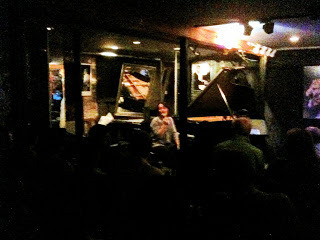
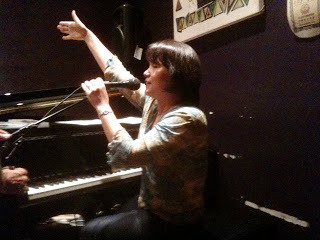
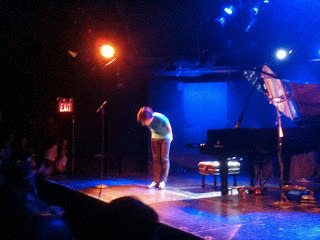
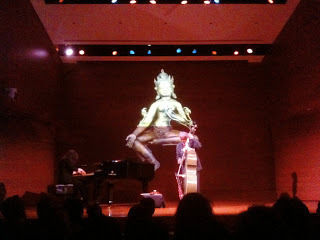
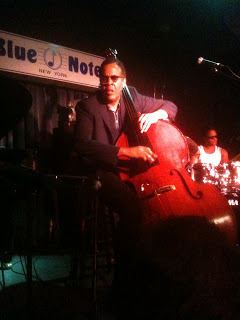
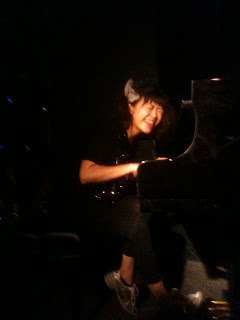
The piano is certainly the most versatile of musical instruments invented by man. I know that it can't produce the delicate quarter tones that the violin or the flute can do. It isn't either well-adapted to the Indian raga or Japanese gagaku. West African percussions, maybe, could be produced by banging on a Steinway, but that's not the intention of the instrument. But I maintain: it is the most versatile instrument invented by man. As evidence, I suggest my experiences from a small number of performances held in New York City in the past couple of months that I was able to attend.
Ayako Shirasaki @ Smalls, 15 September 2010
Ayako Shirasaki is the most amazing up-and-coming pianist around New York City these days. On September 15th, I caught her at Smalls, a club in West Village that distinctly lives up to its name. The place had been set up with rows of folding chairs in front of the grand piano. I preferred to settle down on a high stool at the bar on the side. The tiny place was packed with customers. This was Ayako's solo piano performance to launch her latest CD, Falling Leaves. She was born in Japan and graduated from the Tokyo National University of Fine Arts and Music with a major in classical music, but she then moved to the States to study jazz at the Manhattan School of Music. She never moved back to her native country, although she keeps close links there. In the name of full disclosure, Ayako and I have become friendly over the past several years I've gone to listen to her relatively frequent performances around town.
She started the concert with a Billy Strayhorn classic, followed by Charlie Parker's Confirmation, thus establishing her jazz credentials right at the outset. On the latter piece, the walking bass she played with her left hand while the right hand chased rapid be-bop phrases was impressive, to say the least. The third tune was also a classic, Round Midnight. This Thelonius Monk masterpiece is so gorgeous that just playing the haunting melody is guaranteed to send shivers down one's spine. At the same time it is so harmonically complex that it offers endless pitfalls for the performer to stumble on and creating an improvisation that flows logically is a major challenge to most players. Not to Ayako, who breezed through the harmonies with extraordinary versatility. Smalls is the perfect venue for this kind of music: it's cosy and intimate, not overtly commercial. In many ways it is the prototype image of a New York jazz club from a bygone era.
Ayako Shirasaki is no shrinking violet. Or perhaps it is better to say that her music, like that of Monk, conveys strong emotions without ever becoming schmaltzy. Her technique is amazing and she does virtually anything she wants on the piano. She never fails to amaze me with her left hand virtuosity, no doubt a legacy of her classical training.
The rest of the two-set performance consisted of a number of standards and a few originals, like Monkey Punch, a fluid tune in a brisk tempo; or her own bop creation Three Steps Forward. She played a Bud Powell number in a somewhat aggressive style effortlessly sliding from the Latin groove to a stride piano. Some of the highlights of the evening for me were standards like Someday My Prince Will Come and Turn Out the Lights, to which Ayako gave her on distinct flair. The excellent concert ended with one of my all time favourite tunes, It's Alright with Me. The title also pretty much summarized my feeling.
Puppets Jazz Bar, featuring Arturo O'Farrill and Ayako Shirasaki, 27 August 2010
Not much earlier, I had joined my friends Nanthi and Vasuki at a fund raiser in support of another excellent small club, Puppets Jazz Bar in the Park Slope neighbourhood of Brooklyn. The club philosophy is that it should offer quality music to aficionados while keeping the entrance free. The club makes its money from drinks and the excellent vegetarian fare that it sells. Unfortunately, this doesn't appear to be quite enough to pay for the rent. So on this Friday night, the owner, Jaime Aff, had put together an extraordinary group of musicians who played in a nonstop succession from early evening until late at night. Even then there was no cover charge but buckets were sent around to make a voluntary collection from the full house of fans who had gathered in the small space.
The musicians included such local players as the trumpeter John McNeill and guitarist Randy Johnston. As always, Jaime spent much of the time on stage behind his drum kit backing up several of the other performers. The evening also highlighted two excellent yet very different pianists. Ayako Shirasaki was there, this time with a trio. This is another setting that truly suits her style. The other one was Arturo O'Farrill, the son of the legendary Cuban-born orchestra leader Chico O'Farrill (1921-2001). It was rewarding to be able to enjoy—and compare—the two pianists playing back-to-back. Arturo is a big man hulking over the grand piano. Sitting close by but right behind him it was hard to see what was happening on the keyboard as it was hidden behind his broad back. But hearing the music, there was no doubt that what did happen was very interesting. O'Farrill is a very physical player. He beats the keys with powerful chords and Latin tinged patterns. The force is by no means a substitute for sophistication or intended to hide a lack of technique. On the contrary, his chops are definitely inventive and his melodic sense is most pleasurable. It is just that he has this take-no-prisoners approach to his music.
Taka Kigawa @ Le Poisson Rouge, 26 August 2010
Taka Kigawa is a classical pianist who specializes in modern and contemporary music. I can by no means claim to be an expert in the field, but I've learned much about the music through Taka who is a friend. He performs regularly around town, but one of his favourite locations is Le Poisson Rouge on Bleecker Street in the Village. It is an unusual venue for classical music, as the spacious place also serves as a restaurant and patrons can order food and drinks to lubricate their artistic experience. Departing from established classical music tradition, Taka also behaves as if he were playing at a club. He dresses casually and communicates with the audience in between the pieces, making personal comments on the music and what it means to him. Consequently, despite the less than easily accessible repertoire, Taka has developed a dedicated following and even on this evening the place was packed. Thanks to Taka's wife, Michiyo, and our friend Steve who arrived early, we were able to secure seats at a cramped up table right by the stage.
The recital started with Variations for Piano by Anton Webern, a 1936 composition that is particularly close to Taka's heart. The rather sparse piece silenced the audience forcing us to concentrate on the notes and the spaces in between. From that point on, the mood only intensified. The second composition was Evryali by the French-Greek composer, Iannis Xenakis, which was in stark contrast to the spaciousness of Webern. Evryali hit hard with thick chords and square rhythms. Two contemporary pieces followed: On a Clear Day by the German contemporary composer Matthias Pintscher and Echoes' White Veil by Jason Eckardt. I have to admit that to my ear Eckardt's composition was perhaps the most pleasing of the evening, perhaps because the tune has almost an ECM jazz-like flow to it. The composer was present and Taka introduced him on stage to the audience.
Taka rounded off the recital by Pierre Boulez's First Sonata. As the pianist stepped to the edge of the stage for deep Japanese style bows, the audience broke into a massive applause demanding more. Taka decided to reward the devoted spectatorship with a lovely Debussy rendition that provided a soothing ending to the interesting evening..
Henry Grimes with Marilyn Crispell @ Harlem in the Himalayas, 24 September 2010
A completely different experience was offered by the bassist Henry Grimes who partnered with the pianist Marilyn Crispell at the Rubin Museum of Art as part of the museum's Harlem in the Himalayas –series (the Rubin Museum collections focus on Himalayan arts and culture). This concert took rather a free form, with both of the musicians having earned their laurels in the avant garde jazz scene of the 1960s and 1970s.
Henry Grimes' story is quite incredible and in some ways illustrative of the situation of jazz musicians in the United Sates. The nation hardly treats the masters of its native art form with much reverence. Grimes was one of the top bassists in the heyday of experimental jazz, trusted by such luminaries as Sonny Rollins and McCoy Tyner, as well as by more avant garde experimenters like Albert Ayler, Don Cherry and Archie Shepp. Then in the late-1960s, on a concert tour to the West Coast with Al Jarreau and Jon Hendricks, Grimes' bass was broken and he could not afford to repair it. The Philadelphia man was thus stranded in Los Angeles, without money and a job. This unfortunate episode led to the leading bass man dropping out of the music scene altogether and working as a manual labourer and maintenance man for over three decades. During this period, writing poetry was his creative outlet. Finally, in 2002 he was discovered working in LA by William Parker, a travelling fan from Georgia who then gave Grimes a bass. The old pro went into intensive practice and made his highly successful return to the New York music scene already the following year! At the tender age of 70, he added a second instrument to his repertoire, debuting on the violin!
The performance that night had a high level of energy, with intensive periods of crescendo and overwhelming cascades of notes interspersed with contemplative rubato passages during which Grimes frequently bowed his bass. At one point he also engaged in a dialogue with the piano on his newly found violin. Marilyn Crispell is also a veteran of the contemporary school of acoustic jazz that spurns the conventions of the more traditional strains of the genre. For a decade she played with the innovative composer/saxophonist Anthony Braxton and has performed with many other top names of free jazz persuasion. Not unexpectedly, then, the duo performance was scarce on the more common jazz idiom. Henry Grimes' bass playing did contain elements of the blues and was occasionally even swinging, despite the fact that basically none of the pieces were based on a chord structure or a steady beat. The piano was even less 'jazzy' with Crispell creating whirlwinds of notes that flowed freely over the entire range of the keyboard, at times using the piano more as a percussive instrument, often playing arpeggios like on a harp.
Chick Corea @ Highline Ballroom, 1 October 2010
Yoko couldn't believe that I would get tickets for Friday night when I mentioned the forthcoming Chick Corea Trio performance to her just two days before. In Tokyo, she said, Chick Corea would sell out at least half a year in advance. I am sure she is right that this would be the case in Japan; but not in the States. There are two reasons to this. First and most obviously, New York City has so much going on that even a big name will not be able to sell out his concerts easily. Secondly, jazz here where it was born seems now to be too intellectual music for most of the people. It seems fair to say that America today embraces a culture that glorifies wealth, violence and ignorance—ingredients that characterize much of the popular music of today—and there is a strong anti-elitist stream in the country that is reflected in all spheres, including politics (just think of the Tea Party movement!). Not to paint the whole nation with too broad a brush, I hasten to add, there are very many Americans in this big country who appreciate more sophisticated aesthetics and even tonight the huge locale that is the Highline Ballroom in Chelsea was quite packed.
The Chick Corea Trio consisted of Christian McBride on bass, Brian Blade on drums, and the master himself at the piano. He was his jovial self chatting to the audience in a friendly manner before the trio got to work. The concert was set to start at 8 pm and just ten minutes past the hour when no-one appeared on stage someone started a round of applause that the entire hall joined in. This was repeated in about another ten minutes. When the band appeared on stage shortly after, Chick Corea asked, "Are we too early?"
The trio started with a Kurt Weill tune, displaying the amazing lightness of Chick Corea's touch on the ivory. He just seemed to float on it totally effortlessly. Next came an amazing interpretation of a prelude by A. Scriabin, maybe doing it more justice than the composer had himself ever foreseen when he wrote the beautiful and harmonically complex piece. In Corea's interpretation, it had a lovely ethnic feel and ended with some well timed hand claps by the leader to accentuate the rhythm. It also was the first piece in which the incredibly talented Christian McBride played a memorable solo.
A Monkish tune followed, which Corea confirmed later as being a tribute to the late genius. McBride again played an impressive solo. The bass player is these days seen as something like Ron Carter was two decades ago, towering over the field. McBride is a guaranteed crowd pleaser – and he is truly amazing – but sometimes he appears a prisoner of his own superior technique that at times seems to obscure the purpose of his solos.
A lovely moment followed with a beautiful bolero in which Corea and McBride cooperated wonderfully in unison passages as Blake worked his array of cymbals in a highly sensitive manner. All in all, throughout the evening the trio played together seamlessly. The music was beautiful and Corea's piano playing so effortless that it really seemed light as a feather. Yet, perhaps because of the size of the locale and the location of our table on the balcony overlooking the stage, the performance remained a bit un-engaging and distant.
Stanley Clarke Band featuring Hiromi @ Blue Note, 3 October 2010
Let me state it upfront: The Stanley Clarke Band featuring Hiromi produced the best concert I have witnessed in a long time. We caught the group on the last show of a six night engagement at the Blue Note in West Village. Despite the cold rain and the fact that it was 10 pm on a Sunday night, a long line had formed on the sidewalk outside of the club, a testimony to the star status of the leader. When the Philadelphia native (like the elder Grimes) Stanley Clarke burst onto the scene in the 1970s he was an immediate sensation. The lanky teenager handled the upright bass with amazing dexterity and musicality. Like so many others, I was totally taken by his playing with Chick Corea's original Return to Forever band. Clarke was soon making his own records as a leader while being in demand as a sideman.
At the Blue Note the band featured Ruslan Sirota on electric keyboards and Ronald Bruner, Jr. on drums. But the start of the evening was Hiromi, the piano phenomenon who is making waves on the music scene on both sides of the Pacific. Hiromi Uehara is another Japanese child prodigy who made her debut as orchestra soloist at 12. Now at 31 Hiromi has recorded six excellent jazz CDs under her own name.
The entire band played like a single unit, a result of tight arrangements and discipline imposed by the leader. This didn't take anything away from the spontaneity or creative of the music. On the contrary, this created an amazing tension in the music that was released during periods of untamed improvisation. While the tall and still boyish Stanley Clarke—this time focusing entirely on his acoustic bass—painted some of the most lyrical pictures of the evening in his solos, Hiromi was entirely uncontrollable. The diminutive pixie-like pianist went wild on the grand piano, jumping on her seat as she spanned the entire range of the 88 keys, playing furious runs or beating dense chords. Always inventive, Hiromi's playing avoids any clichés just relying on her amazing technique and most of all talent. It was clear that it was not only the audience who were fascinated with her playing, but she equally inspired the veteran bassist and his band.
These opportunities of hearing half a dozen highly skilled yet so different pianists again proved that the only limits there are to the musical expression are between the ears of the artist.
Published on November 25, 2010 05:52
November 2, 2010
Breathing Zen
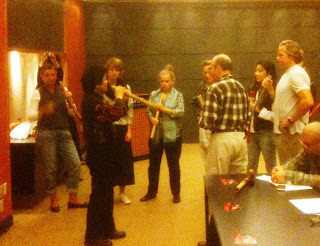
A week ago I participated in a workshop with the shakuhachi master Akikazu Nakamura. The event was organized at the Japan Society in New York on October 24, 2010. Nakamura is one of the greatest contemporary shakuhachi players. He studied the traditional Japanese bamboo flute with master Katsuya Yokoyama and also graduated from the NHK (Japanese broadcasting company) school of traditional music. On top of that, he is an accomplished jazz musician, with degrees from the famous Berklee College of Music in Boston and the New England Conservatory.
The first part of the Sunday afternoon consisted of a workshop on a breathing style called missoku. This workshop had attracted a fairly large crowd of quite a mixed group of people. Most were white, although there were some Asians and African Americans amongst us. The age range was from people in their 20s to those in their 70s. The artistic director of the Japan Society, Yoko Shioya, was curious as she asked for a show of hands why people had joined the workshop. A significant segment raised their hands to affirm that their interest was through shakuhachi, but still a larger group was there because they were interested in Zen. A regular collection of New Age freaks and Buddhist romantics, I thought.
There are basically four types of breathing, Nakamura explained. The most common that we all practise daily are chest breathing and the deeper abdominal breathing. There is also contra-abdominal breathing, practised in particular in yoga, whereby the abdominal movements are opposite to what usually takes place: the abdominal muscles contract when one breaths in, and expand when one breaths out. In missoku, abdominal muscles remain immobile, as the air is pushed out by the diaphragm moving up. Nakamura believes this type of breathing was common in Japan during the Edo Period, but later disappeared. He contended that missoku was actually the feature that made Japanese culture unique from those close to it, like Chinese and Korean cultures. We all practised missoku by sitting still on the edges of our seats. As missoku breathing allows one's body to remain immobile, it is good for work that requires precision. It is also perfect for playing Japanese traditional music on the shakuhachi, as it reduces movement as well as the sound of breathing.
The second part of the evening focused explicitly on the shakuhachi, which meant that more than half of the people in the previous workshop left. The two-hour session was listed as a 'master class', which had slightly intimidated me. Although I have studied the instrument for several years now under the tutelage of a professional recording and performing artist, Marco Lienhard, I had my doubts about whether I'd qualify for a master class or embarrass myself. I shouldn't have worried. This being America, most people possess such self-confidence that they would never have doubts about their own abilities. It turned out that amongst the twenty plus participants, I was clearly amongst the top tier. Perhaps only one, Perry Yung, who is also one of the few established shakuhachi makers in America, actually belonged to a true master class, but a few of us had clearly studied the instrument with some seriousness. To my astonishment, a number of people who had decided to take the master class were actually complete beginners, some barely that. This clearly surprised the sensei as well, who gently suggested that if he comes back it might be better to divide the class into beginners and more advanced players, so that he might be able to better teach both groups.
Nonetheless, we proceeded with the class and Nakamura turned out to be an excellent teacher. Our object of study was 'Hon Shirabe', a classic shakuhachi honkyoku meditation. We spent more than an hour just honing the phrases of the first half – just five lines – of the piece. I had tried to play the piece also earlier and was quite familiar with it. Yet, Nakamura's explanations and demonstrations allowed me to understand the tune better than ever before. Just for this, it was worth participating in the class.
As a bonus – or a present to us, as the master himself said – Nakamura proceeded to play two classic numbers for us. The first, 'Tsuru no sugomori' (or 'Cranes nesting'), is a standard in the shakuhachi repertoire. Like so often, there are many slightly different versions of the piece being played and this night Nakamura played the most complete and complex version of the song, depicting two wounded cranes returning to their nest. When their chicks hatch, it is time for the parents to die. This sad piece of farewell demonstrates the Japanese sense of beauty found in the impermanence of life. From the point of view of the player, it requires admirable technique to reproduce the cries of the cranes and the twittering of the chicks. Akikazu Nakamura produced the whole landscape of sounds from his flute taking us to the foggy marshes of Western Japan where the red-crowned cranes nest.
The second piece was even more amazing. It was called 'Saji', which refers to the compassion of Bodhisattva. This piece was originally played by a monk called Shinshichi who introduced it to the Ichoken komuso temple in Hakata on the Japanese island of Kyushu. From there it found its way to Kyoto and became known in the shakuhachi catalogue. However, it is very rarely played because it is so difficult. Nakamura said that he only was able to start playing the song after he mastered missoku breathing. He also used circular breathing in order to be able to play the long fluid and dramatic segments of the tune with interruption. Akikazu Nakamura was the first shakuhachi player to develop a circular breathing technique. This technique is common with, especially oboists, but is also used by a number of jazz saxophonists and trumpeters (the most famous of whom must have been Rahsaan Roland Kirk). The idea is to push the air from your mouth into the horn using your muscles while breathing in through the nose, so as to produce an uninterrupted flow of air into the instrument. With a shakuhachi, this is particularly difficult, because any movement in the cheeks or upper lip inevitably changes the tone and the pitch. Faced with this dilemma, Nakamura developed a technique whereby he stores the air into the lower part of his mouth. 'Saji' left all of us spectators more breathless than the missoku-breathing master.
When the class was over and we spread out into the dark and cool autumn air in Dag Hammarskjöld Park, I was awed by the experience and inspired to redouble my own study of the wonderfully expressive instrument. A few blocks away on Second Avenue I was caught up by one of the participants, a friendly lady of a certain age. She explained to me that she loved flutes and was a collector of all kinds of wooden and clay flutes and ocarinas. She had heard the shakuhachi and thought it sounded free-flowing. Tonight she had learned that there are subtle and definite rules that guide shakuhachi music. While, she confessed, she had not understood much of the explanations by the teacher, she had realized that the shakuhachi indeed required serious study. Her enthusiasm and newly found humbleness convinced me that it was after all not so bad to have the novices in the class. Still, I hope that next time the class will be split into two.
Published on November 02, 2010 15:12



